Almost right next to the Wat Phan Tao temple, about which I wrote in the previous sequel of the story about my travel in Thailand, there is another significant temple – Wat Chedi Luang.
The temple founded in the late 14th century and considered one of the most important temples in the Chiang Mai region is surrounded by ancient walls.
Within the temple complex, there are two viharas. The larger one, visible from the street, was built in 1928 with a three-tiered roof and has its front decorated with a large area covered in golden colour. However, during my stay in northern Thailand, it was closed to visitors since it was obviously undergoing a restoration, as seen in the picture on the right-hand side, so I didn’t explore it further.
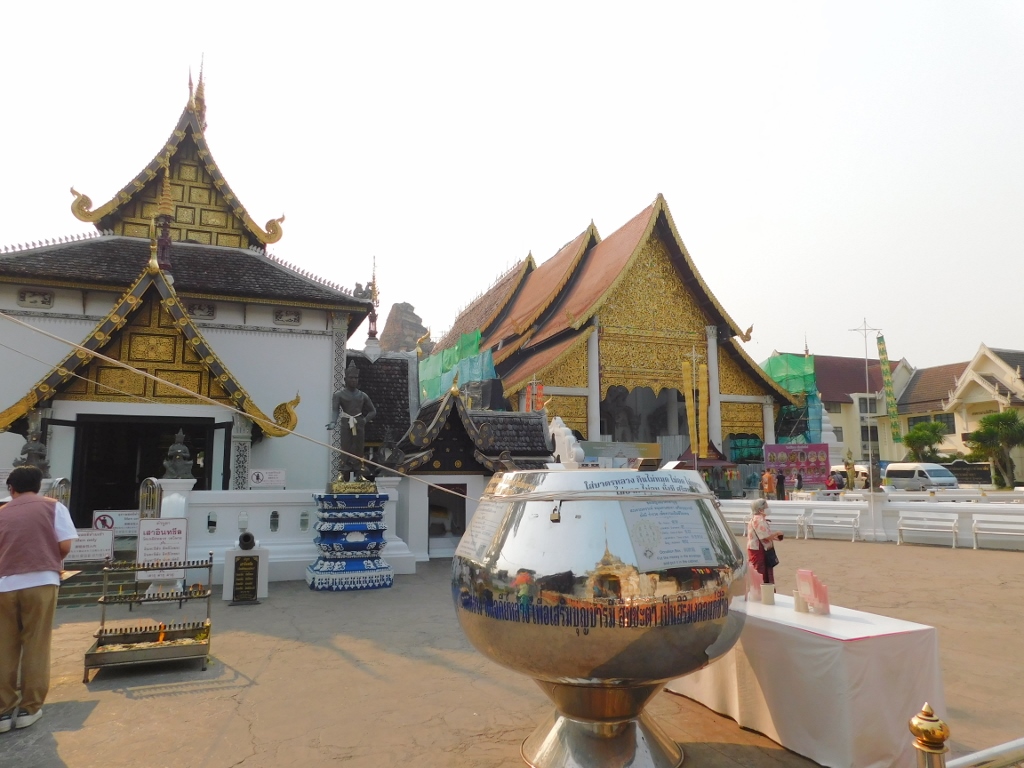 Wat Chedi Luang
Wat Chedi Luang
What is very important within the front part of this temple complex is the City Pillar. I have mentioned earlier that there is a tradition in Thailand for larger cities to have their sacred pillars around which shrines are built. This can be seen in the previous photo on the left-hand side.
But, when I entered the temple complex area, the first thing I encountered was actually the Southern Pavilion from 1800, where a Yaksha, a large demon guardian, can be seen, watching over the City Pillar of Chiang Mai.
 Wat Chedi Luang, Southern Pavilion
Wat Chedi Luang, Southern Pavilion
However, before delving into the shrine with the City Pillar, first I took a stroll through this part of the temple complex, as it was very colourful and filled with numerous interesting details.
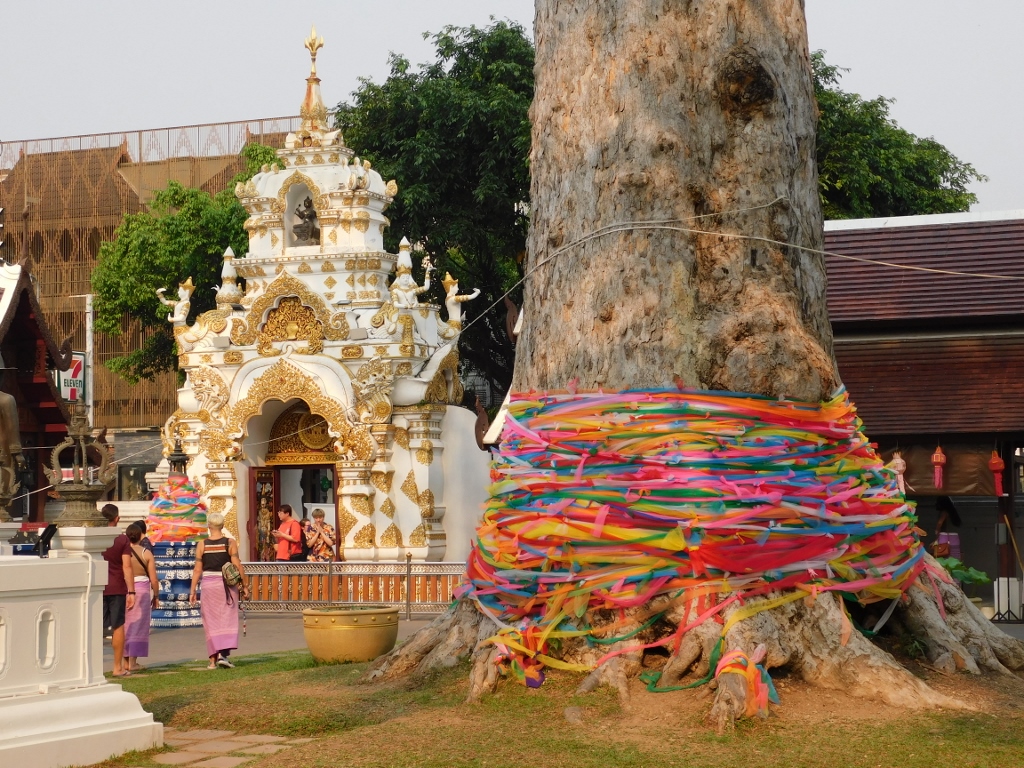 Wat Chedi Luang, a detail
Wat Chedi Luang, a detail
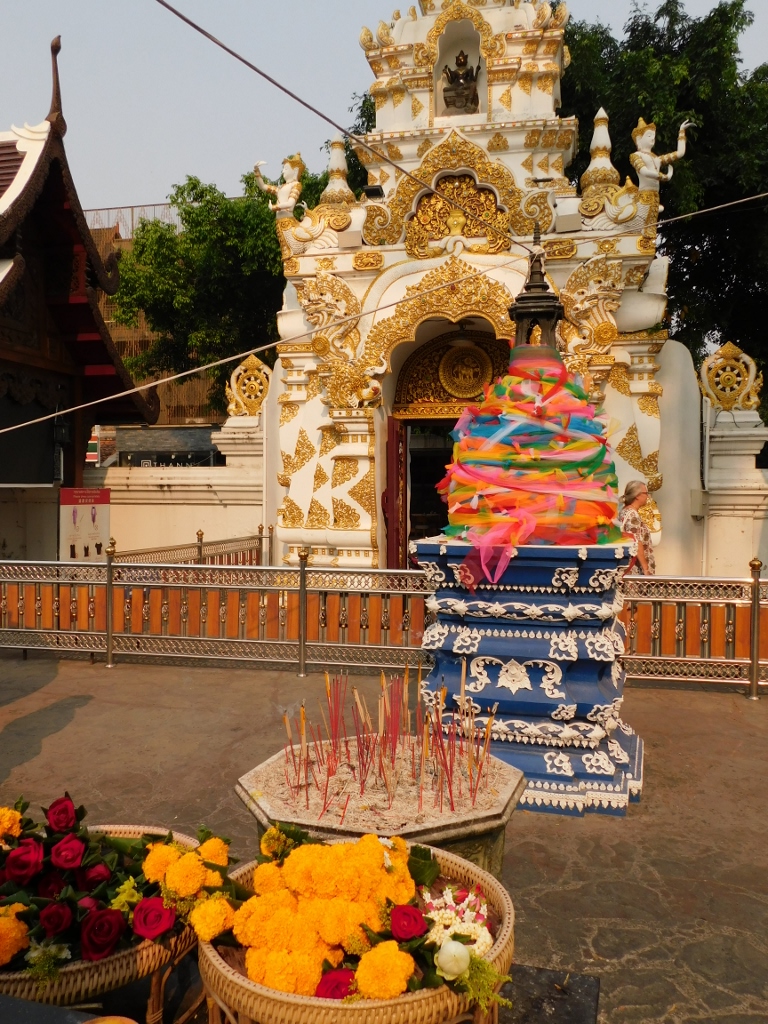 Wat Chedi Luang, a detail
Wat Chedi Luang, a detail
As for the City Pillar shrine, it is a smaller square-plan structure where the sacred City Pillar, believed to protect the city, is kept. Originally, in 1296, the pillar was installed in a nearby temple called Wat Inthakhin, but it was relocated here in 1800.
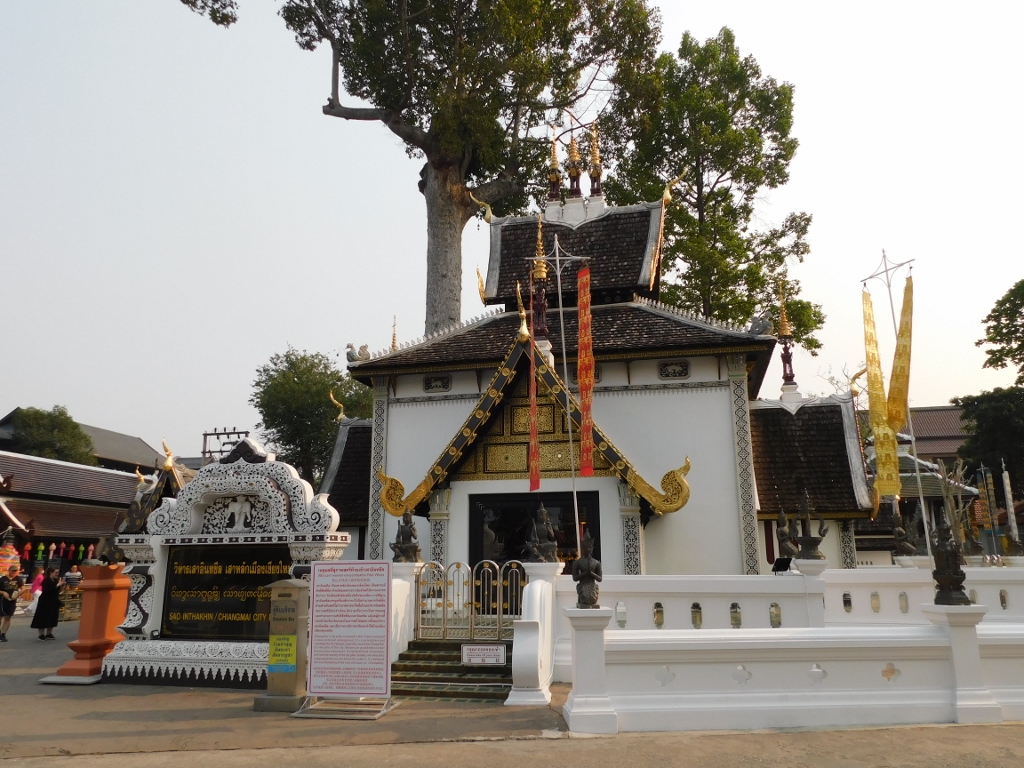 Wat Chedi Luang, City Pillar shrine, north side
Wat Chedi Luang, City Pillar shrine, north side
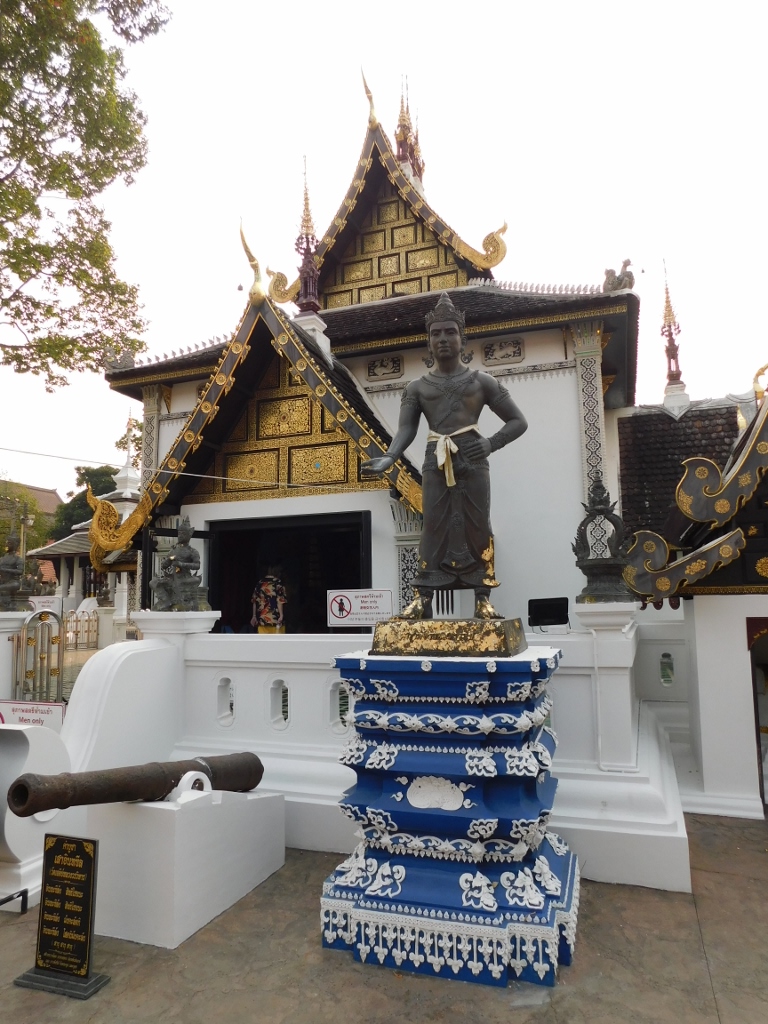 Wat Chedi Luang, City Pillar shrine, east side
Wat Chedi Luang, City Pillar shrine, east side
By the way, this specific pillar is called Sao Inthakhin, which means the pillar of the god Indra. According to the legend, Indra sent this pillar through his demons to the Lawa people who inhabit northern Thailand and it was then buried underground. In connection with this, a statue of god Indra riding his three-headed elephant, Airavata or Erawan in Thai, can be seen here.
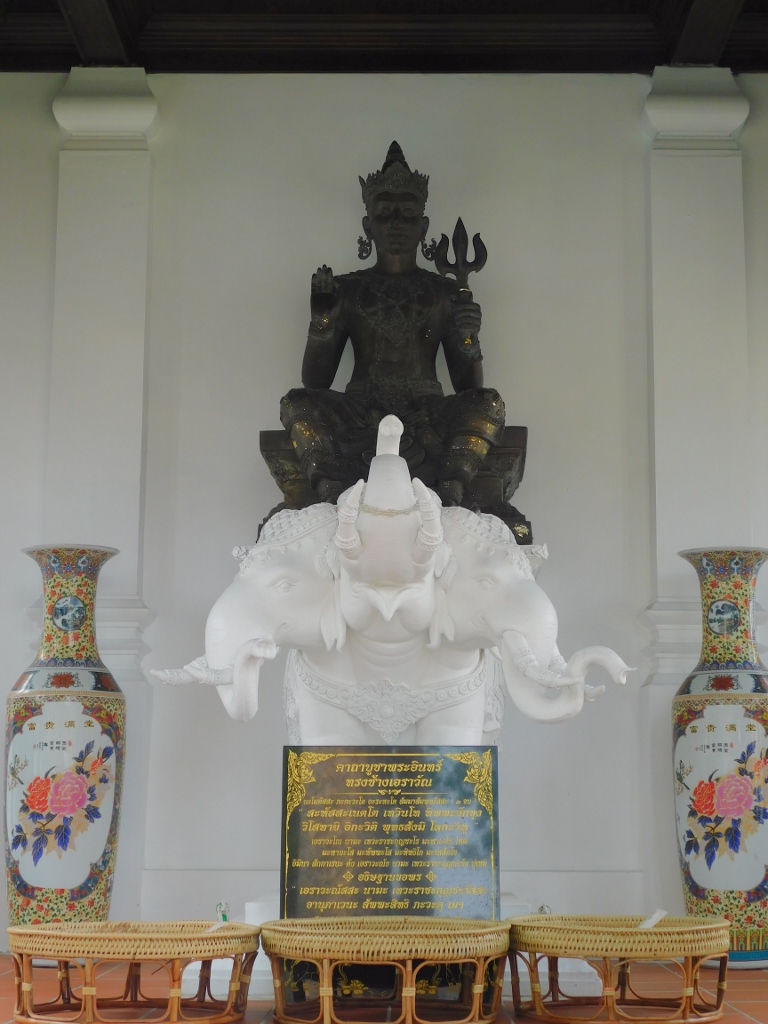 Wat Chedi Luang, Indra on his Erawan
Wat Chedi Luang, Indra on his Erawan
However, what struck me as particularly unusual here is the following – women are not allowed to enter the shrine!
As I’ve said, the pillar is buried underground and it is a highly sacred pillar that Thais, especially the inhabitants of Chiang Mai, deeply respect and worship. However, the issue with women is that they menstruate and it is believed that this “humiliates and ruins the sanctity of the city pillar.” In order to be somewhat politically correct, the information board states that even men who are not appropriately dressed cannot enter. There was no one to ask, while I was curious about what happens with women who have reached an age where there is no longer a “blood-related” barrier to visiting the shrine – can they enter or is their presence still considered offensive?
Since I am not a Buddhist, I personally don’t have issues with such restrictions and although I’ve overcome my personal feminism a long time ago (I am now in the post-feminist phase of life), I must admit that this sounds a lot like human interpretation of divine intentions, which I often find extremely questionable. Either way, I had no intention of entering, but I did take a peek and took some photos there.
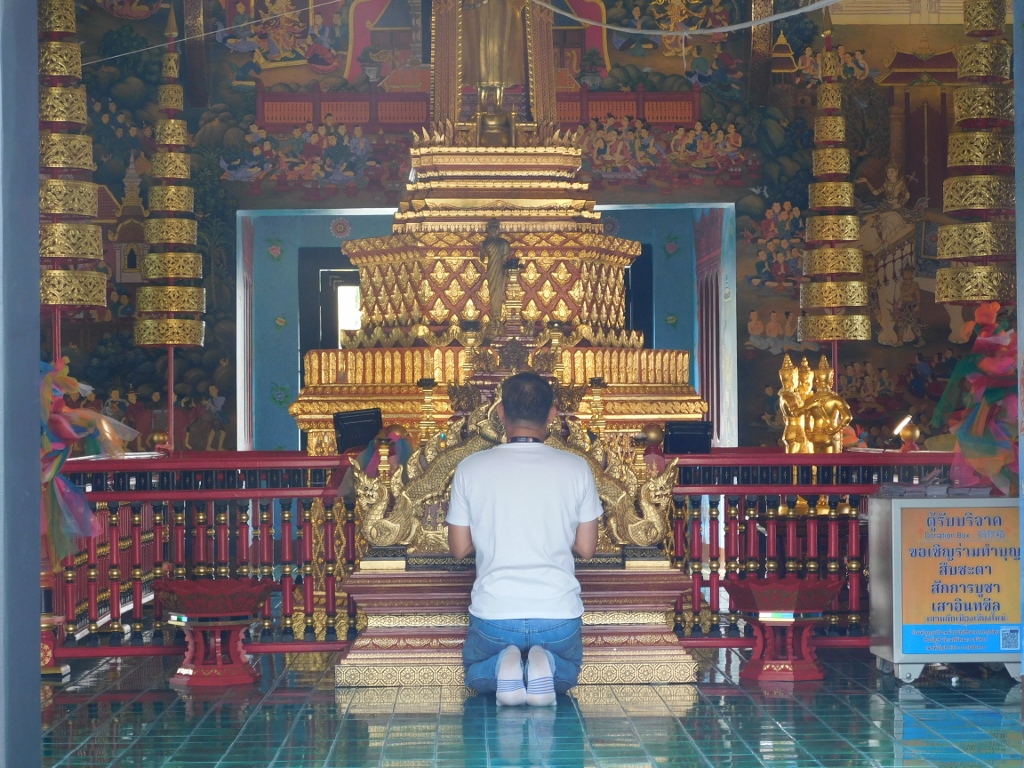 Wat Chedi Luang, City Pillar shrine, the interior
Wat Chedi Luang, City Pillar shrine, the interior
Right next to this shrine is a small southern chedi, almost 16 metres tall, and just a few dozen metres away there is the large vihara I have mentioned earlier that was closed for reconstruction.
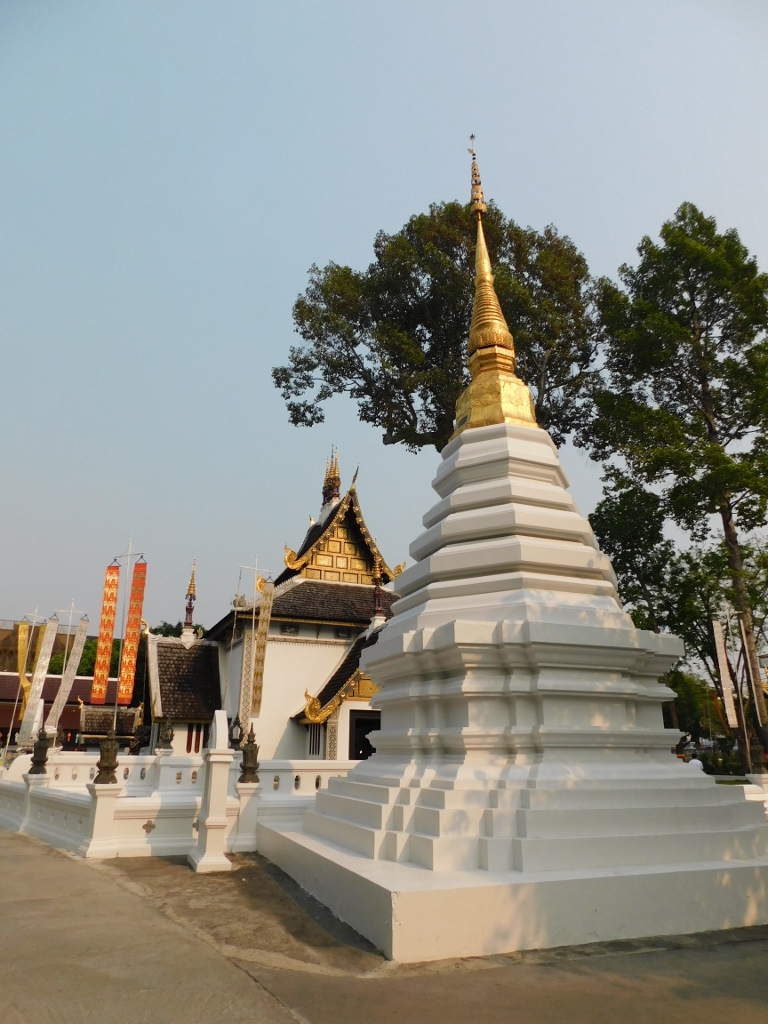 Wat Chedi Luang, smaller southern chedi
Wat Chedi Luang, smaller southern chedi
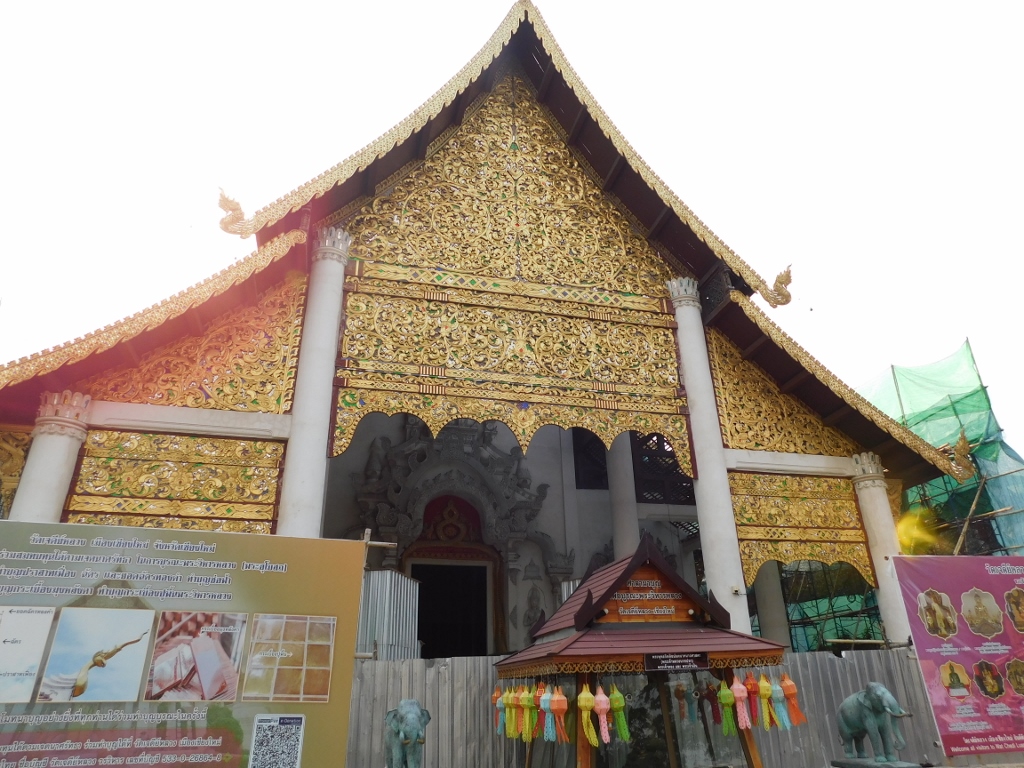 Wat Chedi Luang, big vihara
Wat Chedi Luang, big vihara
Now I headed towards the centre of the temple complex and its largest structure, but along the way, I passed by some other places that seemed interesting. Once again, I came across a golden fabric that was rolled from one bolt onto another, while being written on in the meantime. However, here I finally found information on what needs to be done with it, so I can convey that now. Anyone interested can make a donation and write their name on the golden fabric.
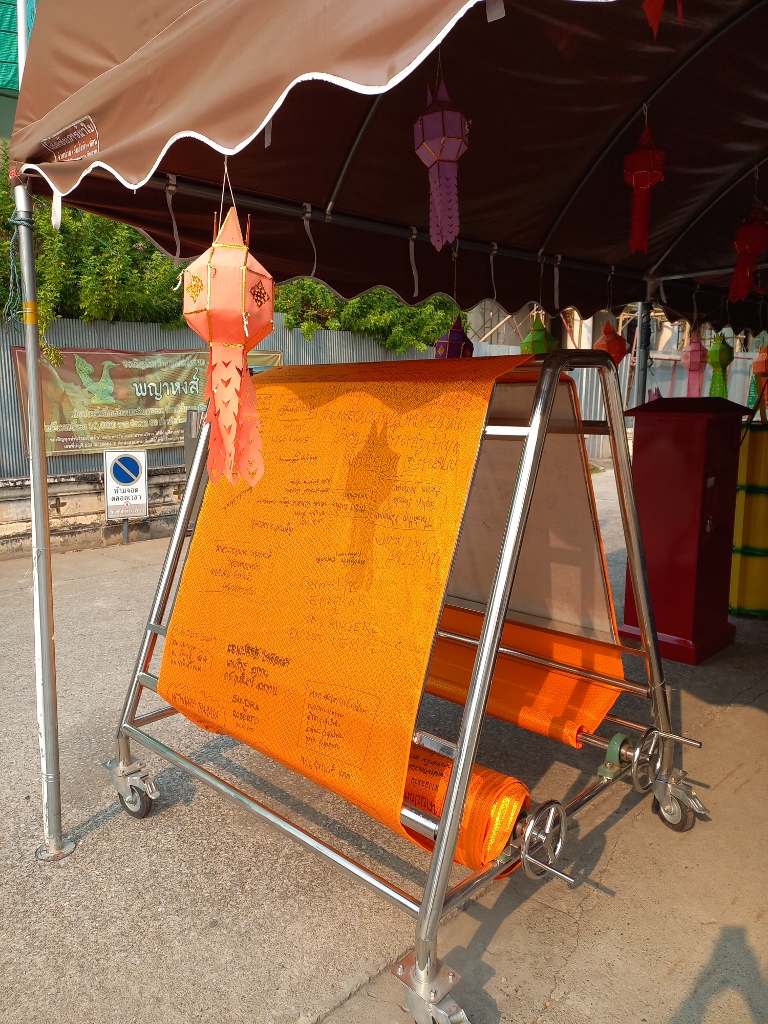 Wat Chedi Luang, a detail
Wat Chedi Luang, a detail
But, donations can also be made in other places in this part of the temple – for example, for the purchase of coffins for funerals. There are also dressed skeletons with hands folded in a prayer gesture.
 Wat Chedi Luang, a detail
Wat Chedi Luang, a detail
Here, various plants can also be seen and a couple of them were in bloom during my visit – for instance, a cannonball tree (Couroupita guianensis) or a lotus (Nelumbo nucifera) growing in a large pot filled with water. Although quite different, both of these plants are frequently seen in Thai temples due to their cultural significance.
 Wat Chedi Luang, a cannonball tree flower
Wat Chedi Luang, a cannonball tree flower
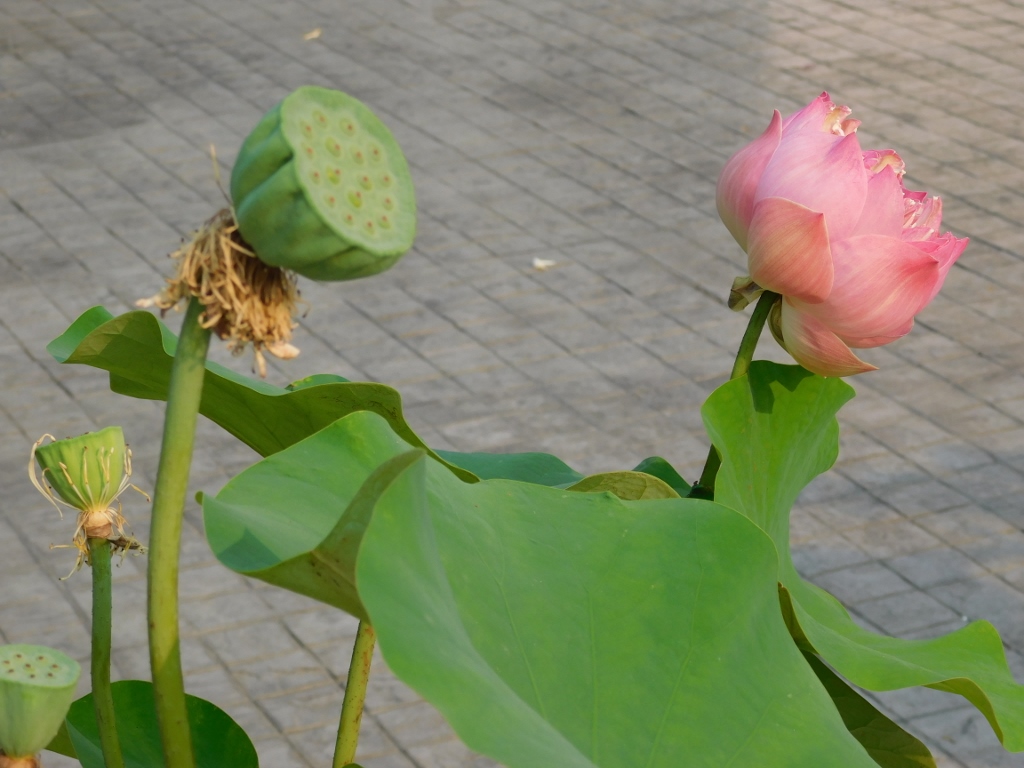 Wat Chedi Luang, lotus
Wat Chedi Luang, lotus
But, people most often come to Wat Chedi Luang because of its central chedi, while the very name of the temple means “temple of the great chedi” and it's quite clear why.
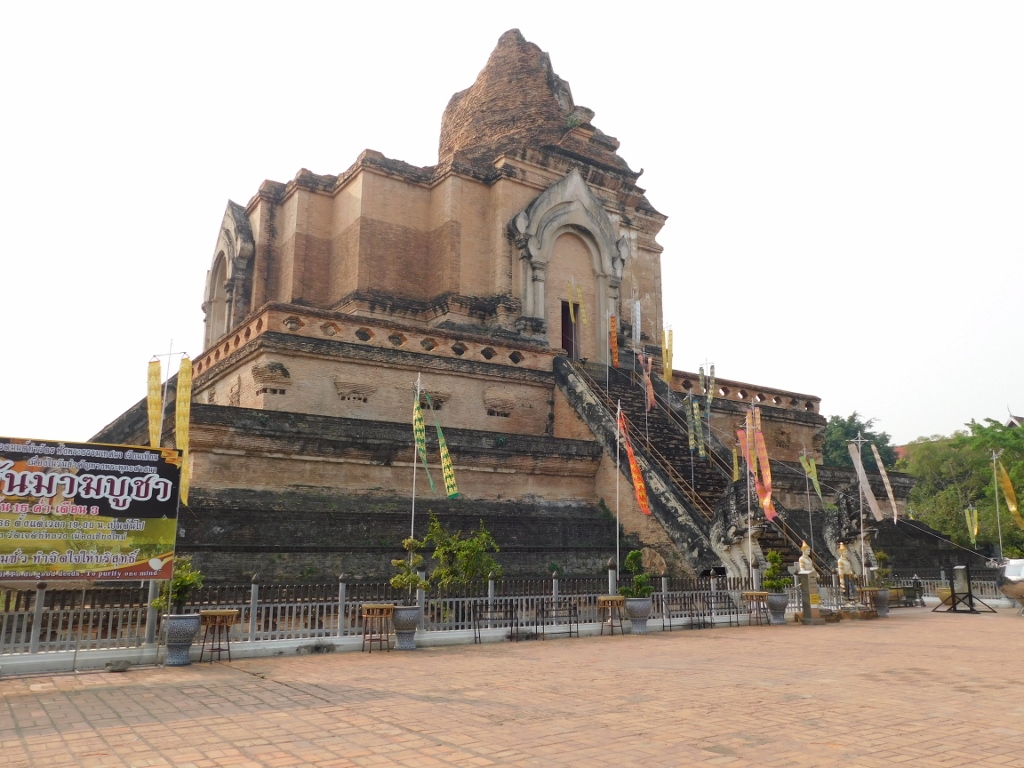 Wat Chedi Luang, central chedi, east side
Wat Chedi Luang, central chedi, east side
This is a huge and very impressive chedi erected to enshrine the ashes of the father of the king who founded the temple.
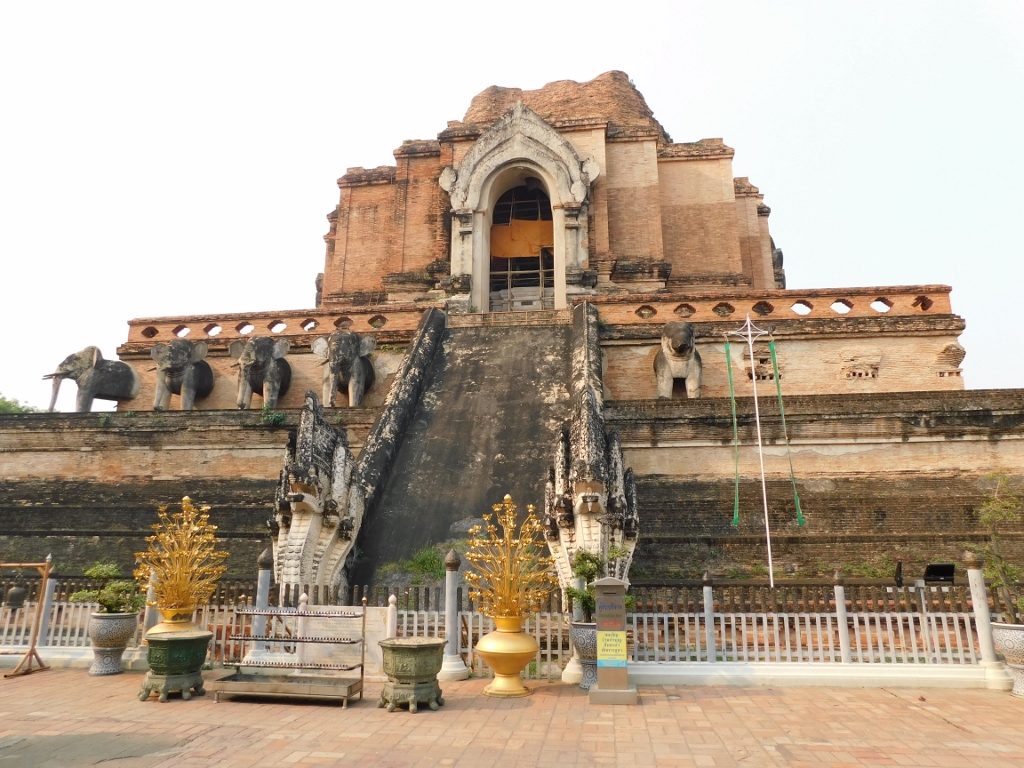 Wat Chedi Luang, central chedi, south side
Wat Chedi Luang, central chedi, south side
I have already mentioned earlier that the temple was founded in the late 14th century and it is known that the construction of the chedi took a long time. However, different sources provide varying years, but they all point to the 15th century. Be as it may, in the end the chedi stood at a height of 85 m, with a width of 44 m, making it the largest structure in Chiang Mai at the time. In 1545, a significant part of the chedi collapsed due to an earthquake, but it was partially restored in the 1990s.
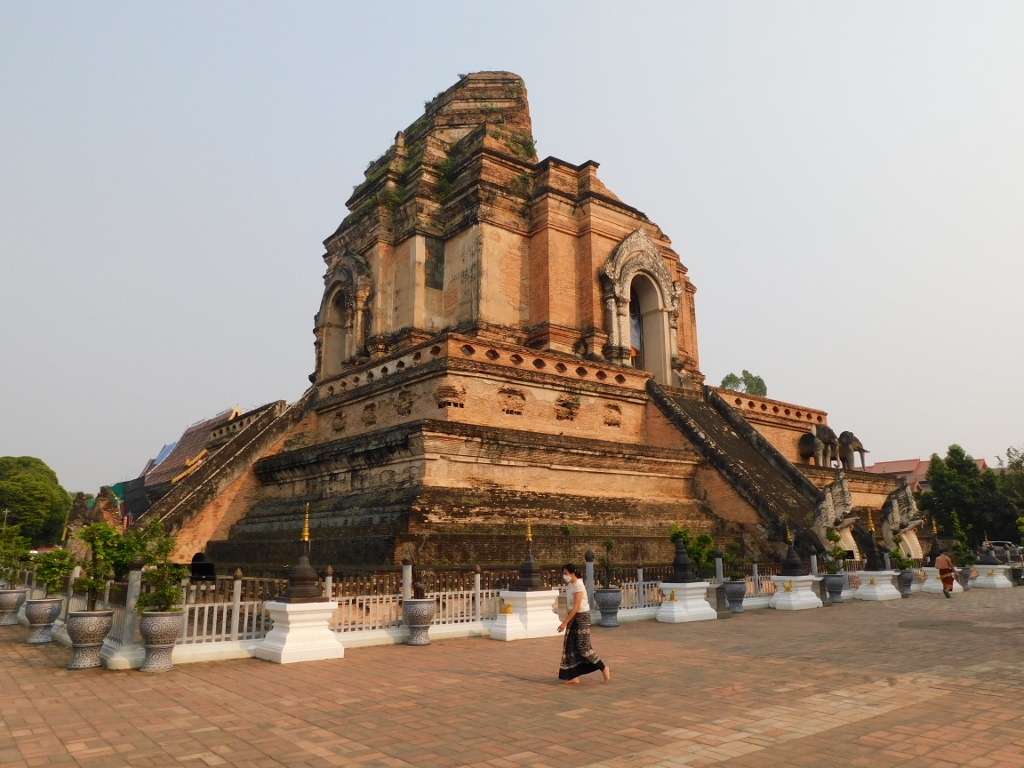 Wat Chedi Luang, central chedi, northwest side
Wat Chedi Luang, central chedi, northwest side
On all four sides, there are wide staircases adorned with impressive Nagas, mythical serpents serving as guardians. At the top of the staircases, there are niches where Buddha statues were originally placed.
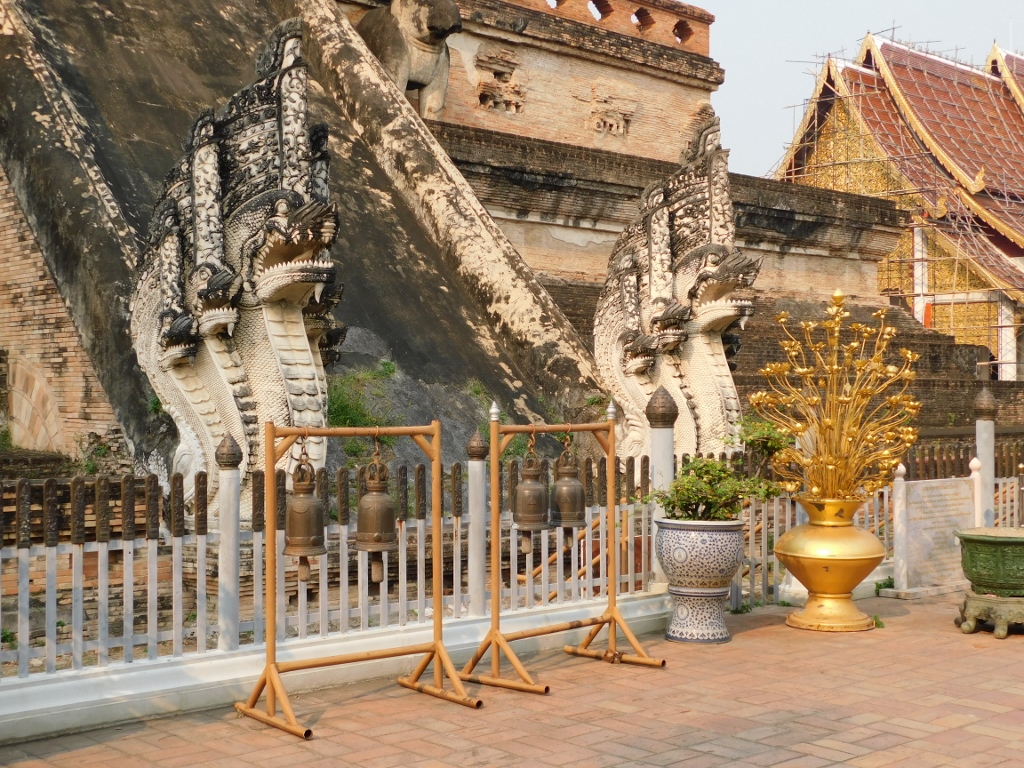 Wat Chedi Luang, central chedi, Nagas guarding the staircase
Wat Chedi Luang, central chedi, Nagas guarding the staircase
On the level just below the top of the staircase, there is a broad band featuring stone figures of elephants emerging from the chedi.
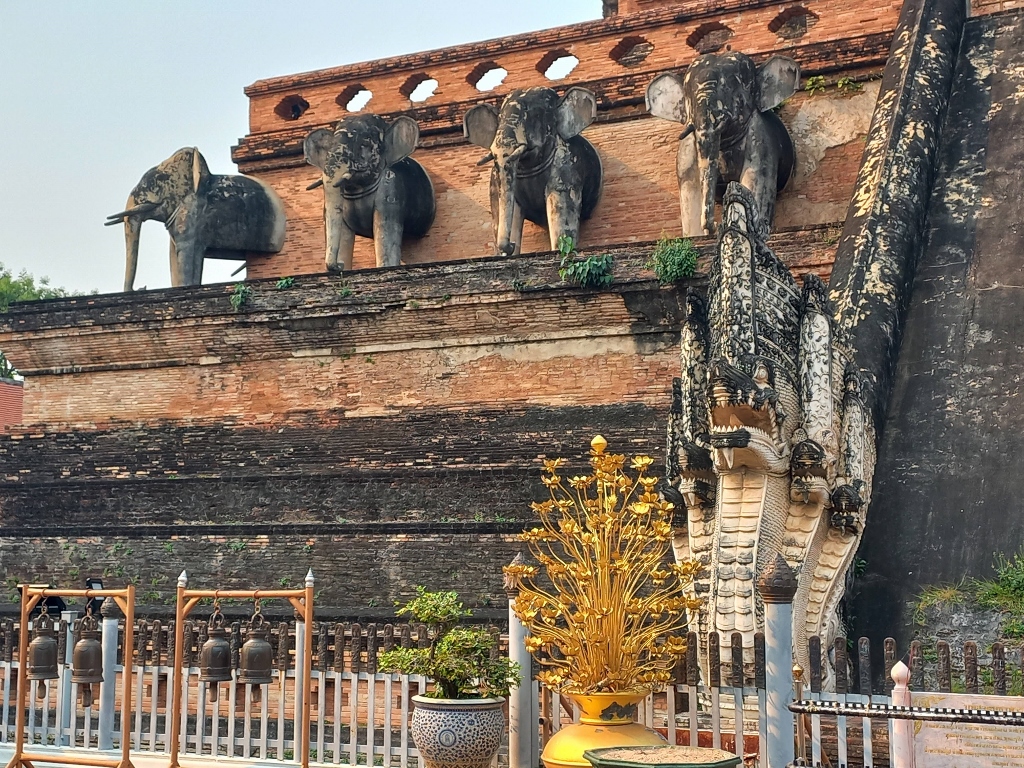 Wat Chedi Luang, central chedi, a detail
Wat Chedi Luang, central chedi, a detail
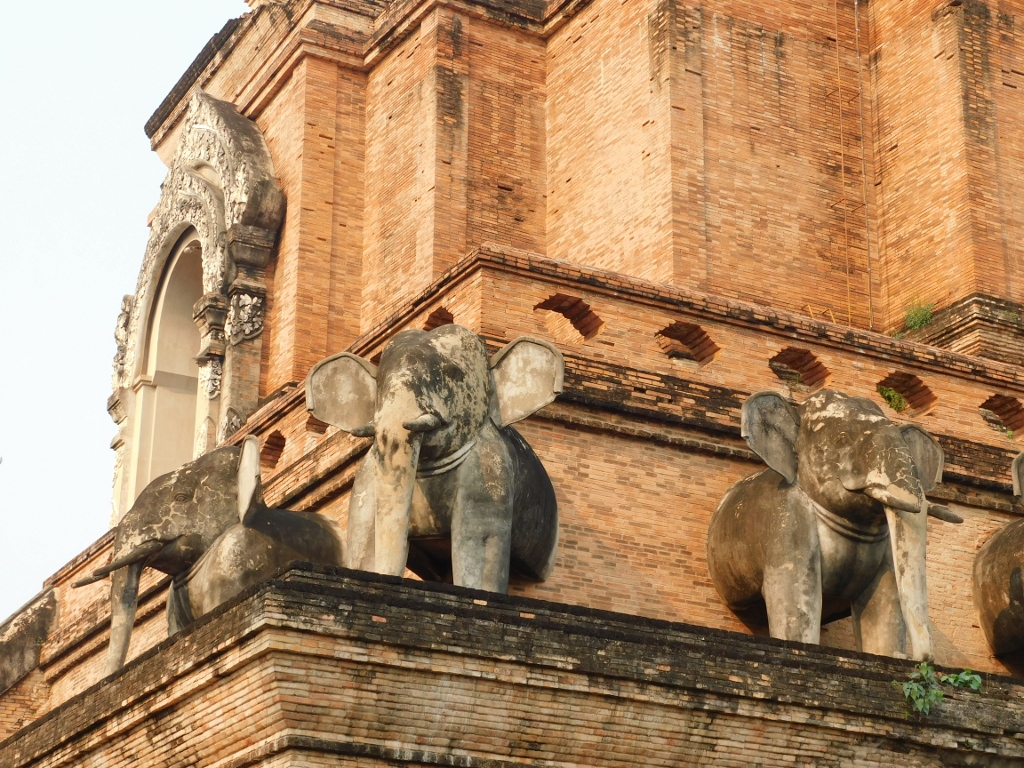 Wat Chedi Luang, central chedi, a detail
Wat Chedi Luang, central chedi, a detail
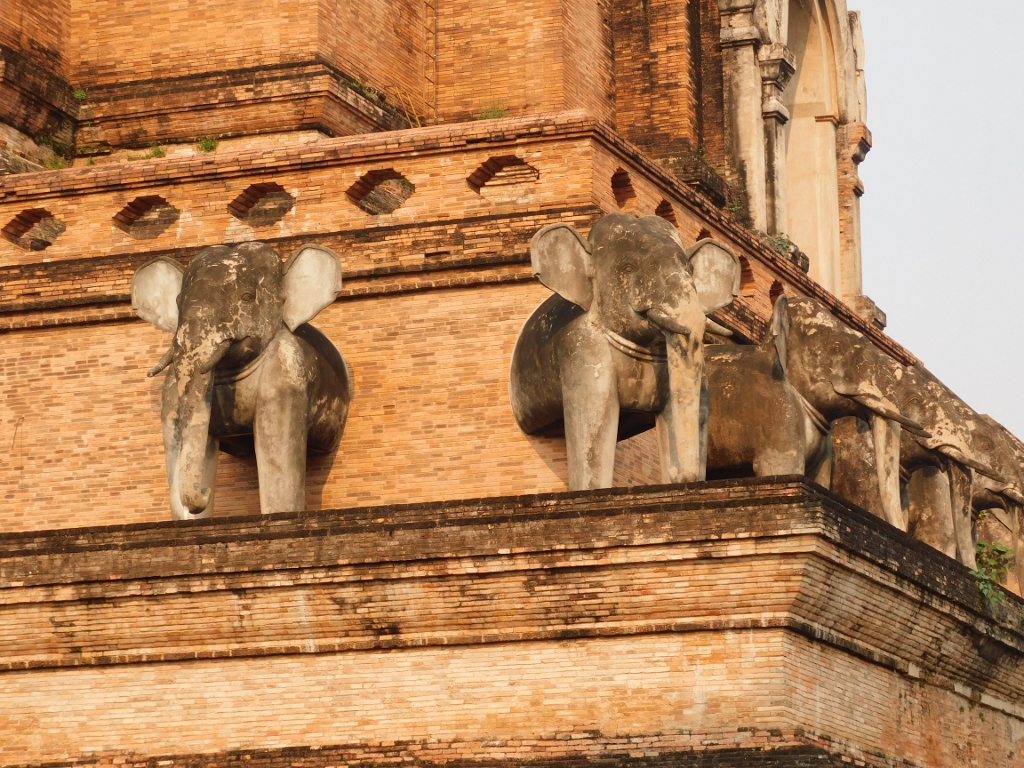 Wat Chedi Luang, central chedi, a detail
Wat Chedi Luang, central chedi, a detail
 Wat Chedi Luang, central chedi, a detail
Wat Chedi Luang, central chedi, a detail
The Emerald Buddha, the most important and revered Buddha image in Thailand, was housed in this temple from 1468 to 1552, about which I have already written (https://www.svudapodji.com/en/thailand-7/).
To the west of the central chedi, there is a series of various structures and each one of them is impressive in its own way.
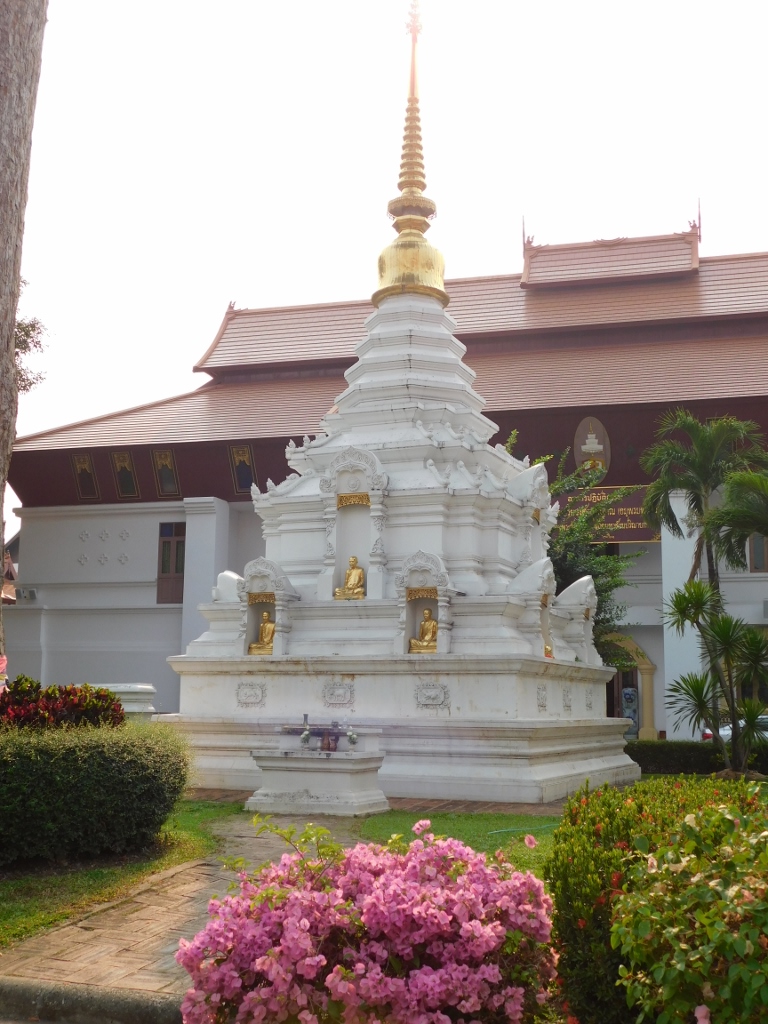 Wat Chedi Luang, a small chedi
Wat Chedi Luang, a small chedi
Among them is a particularly picturesque smaller vihara with a fantastically beautiful front facade guarded by Nagas at the entrance. Behind it, there is a small pavilion built in the Burmese style.
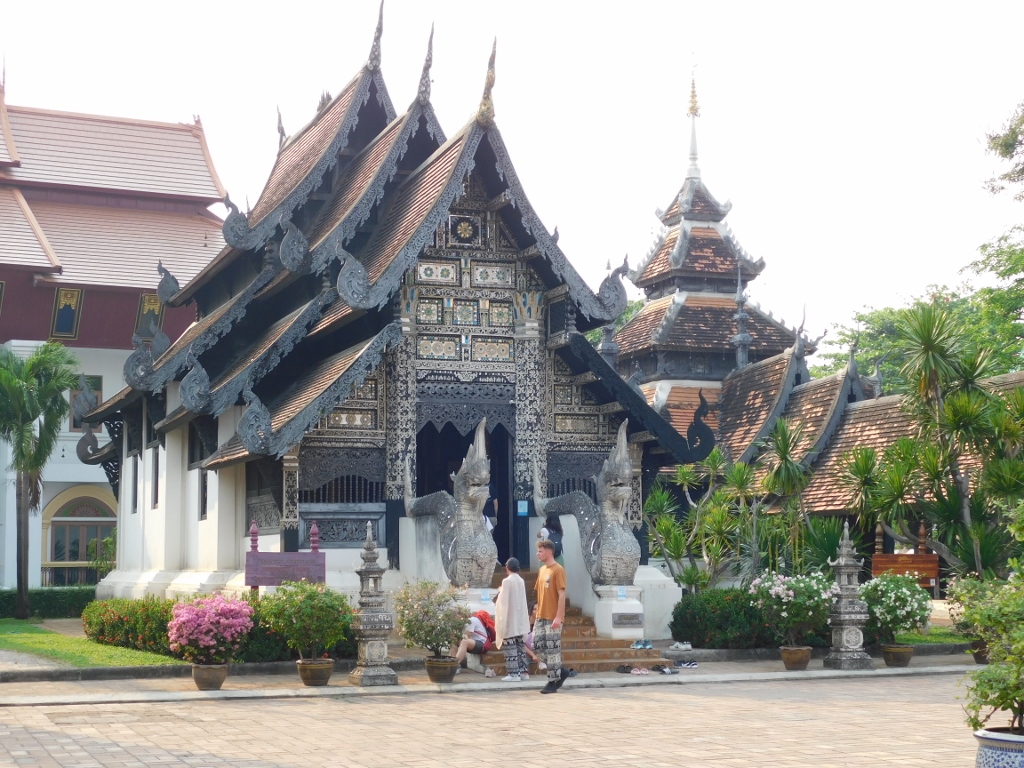 Wat Chedi Luang, smaller vihara
Wat Chedi Luang, smaller vihara
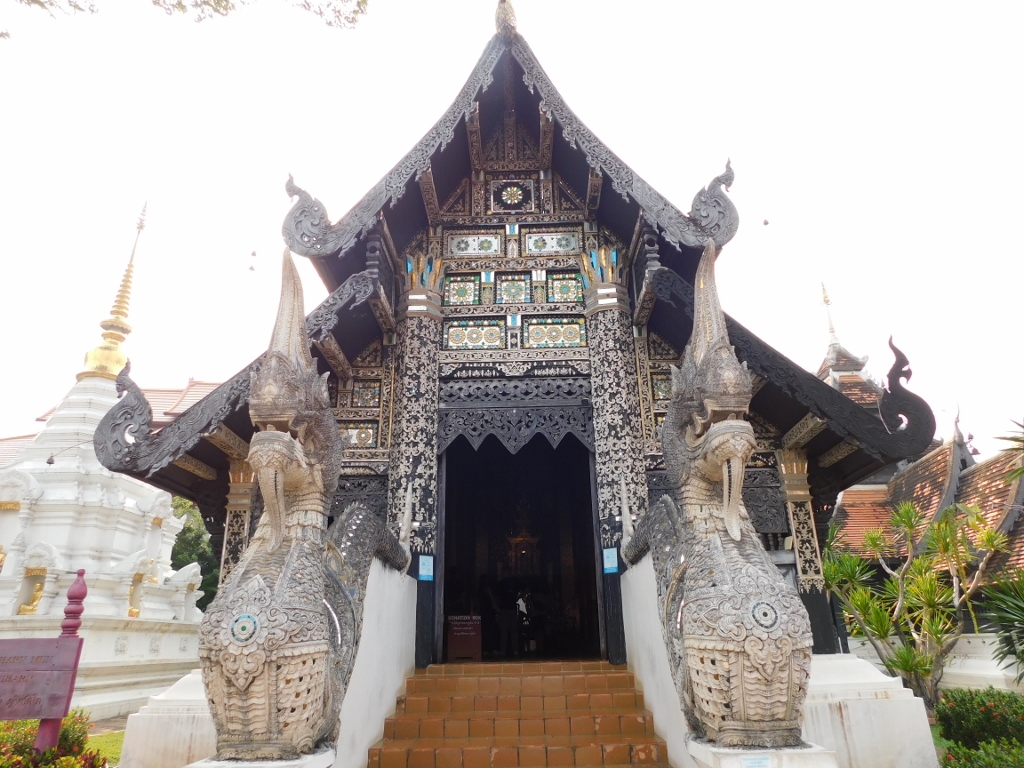 Wat Chedi Luang, smaller vihara, front side
Wat Chedi Luang, smaller vihara, front side
Here, inside the vihara, there is a wax figure of a monk named Adjahn Mun Bhuridatta (1870-1949) enclosed in a glass “cage.” Not only did he spend some time at this temple, but he is also considered the greatest Zen master of modern Thailand.
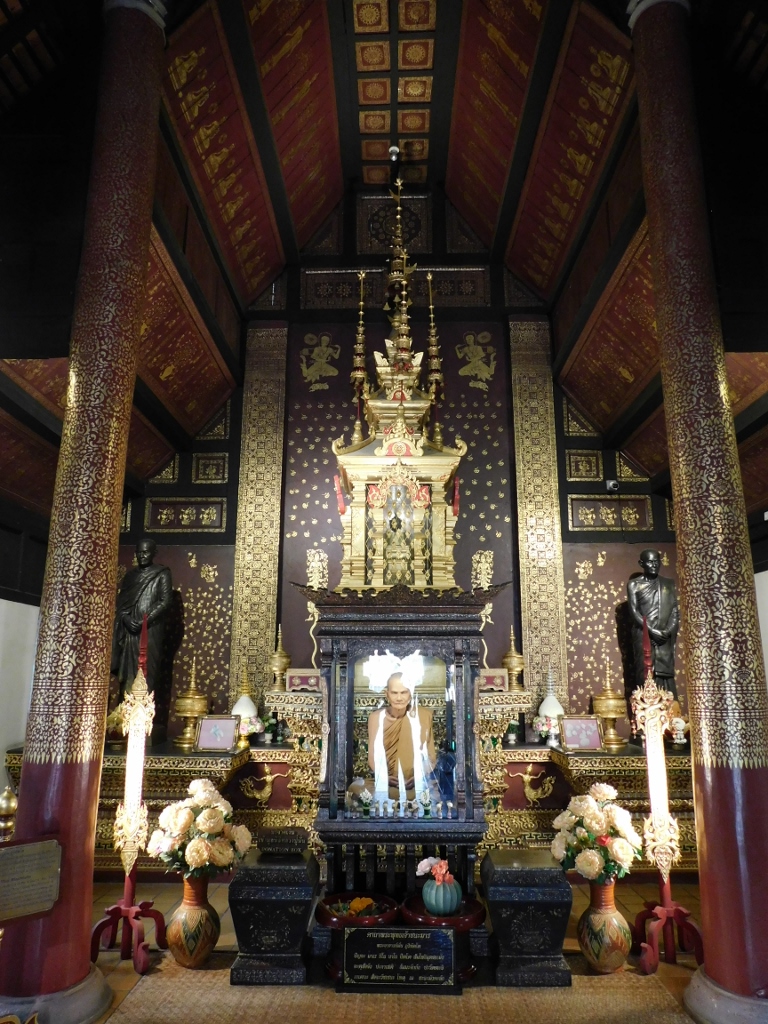 Wat Chedi Luang, smaller vihara, the interior
Wat Chedi Luang, smaller vihara, the interior
When I stepped outside, I was amazed by the impressive view of the central giant chedi and the Nagas.
 Wat Chedi Luang, a detail
Wat Chedi Luang, a detail
I also went, of course, to the adjacent Burmese-style pavilion that was also very interesting, not only from the outside but also from the inside.
 Wat Chedi Luang, pavilion
Wat Chedi Luang, pavilion
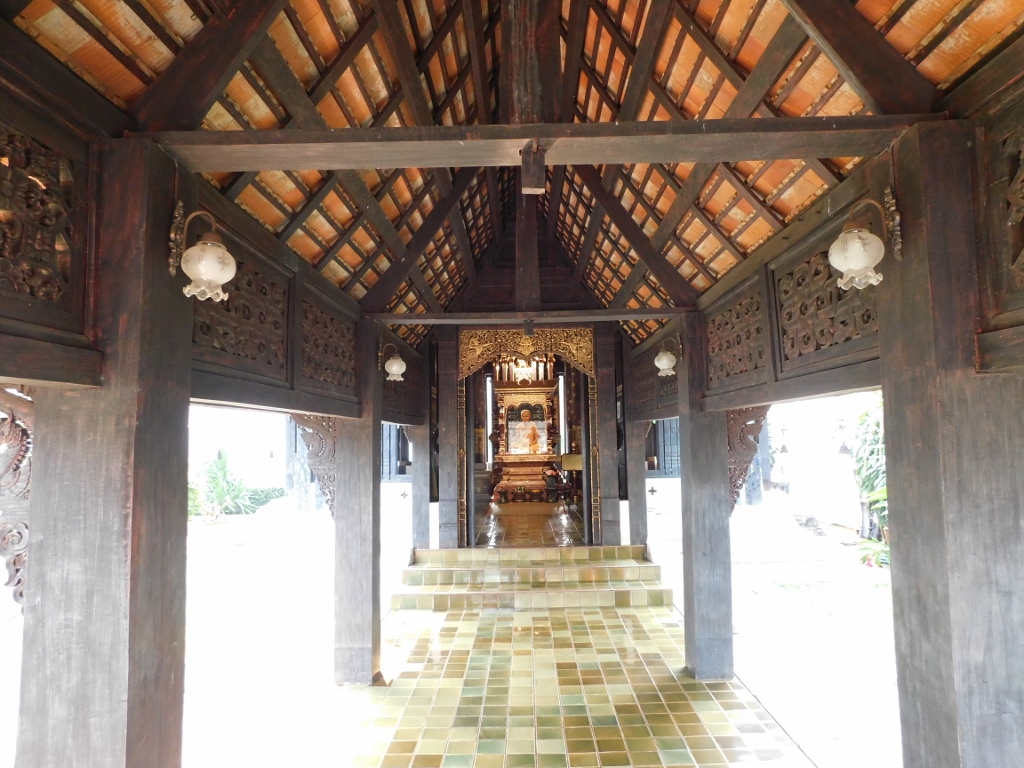 Wat Chedi Luang, pavilion, access open hallway
Wat Chedi Luang, pavilion, access open hallway
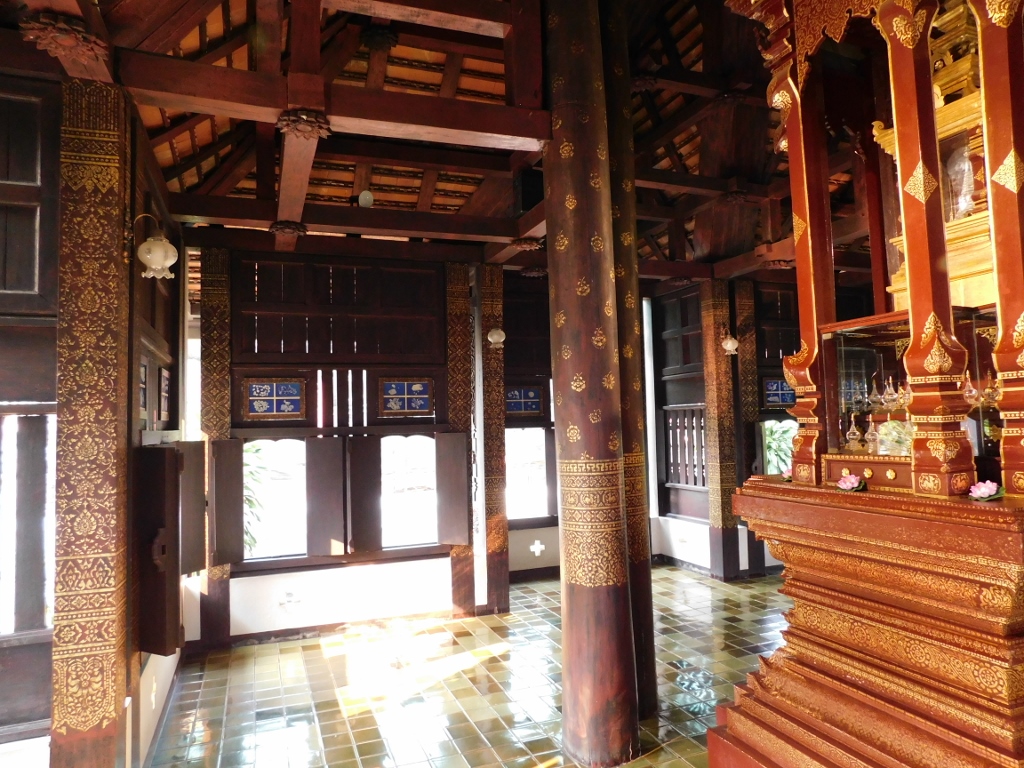 Wat Chedi Luang, pavilion, the interior
Wat Chedi Luang, pavilion, the interior
Among other things, again I encountered here an impressively crafted wax figure. It is evidently a significant monk, but I am not aware of any details about him. I was primarily impressed by the realism of the figure’s craftsmanship – one could easily think it is a living person, except for being enclosed behind glass panels.
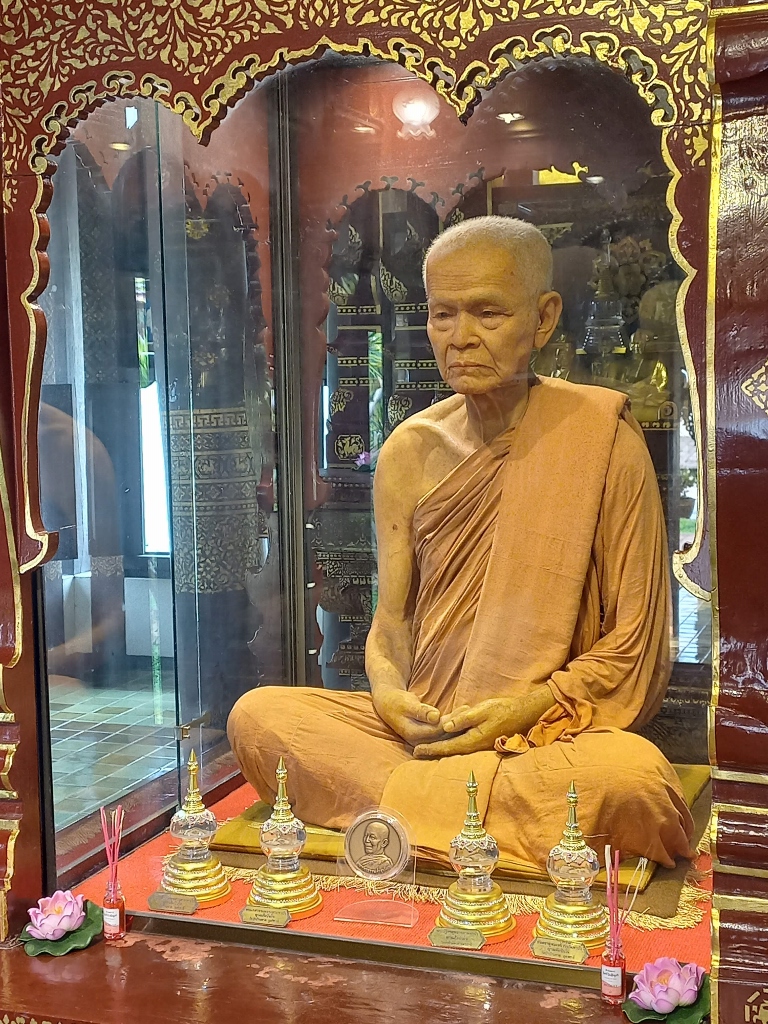 Wat Chedi Luang, pavilion, a detail
Wat Chedi Luang, pavilion, a detail
Further down the line, there are a few more small and interesting wooden structures, but within them and in the spaces between, various intriguing figures can also be observed.
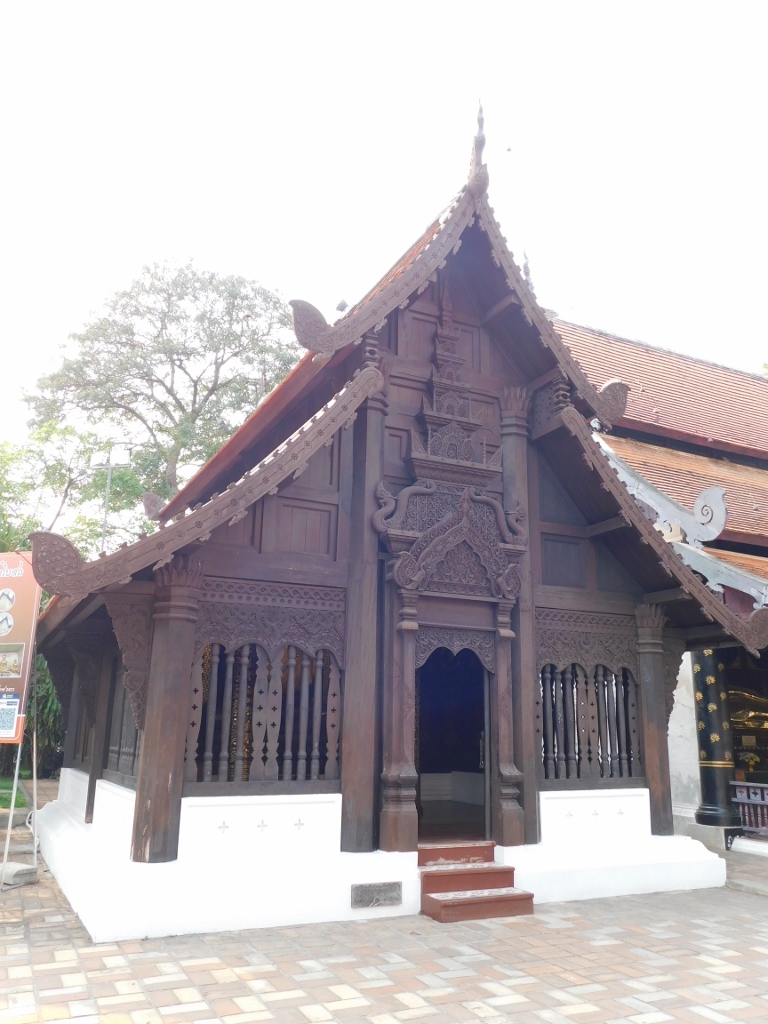 Wat Chedi Luang, a detail
Wat Chedi Luang, a detail
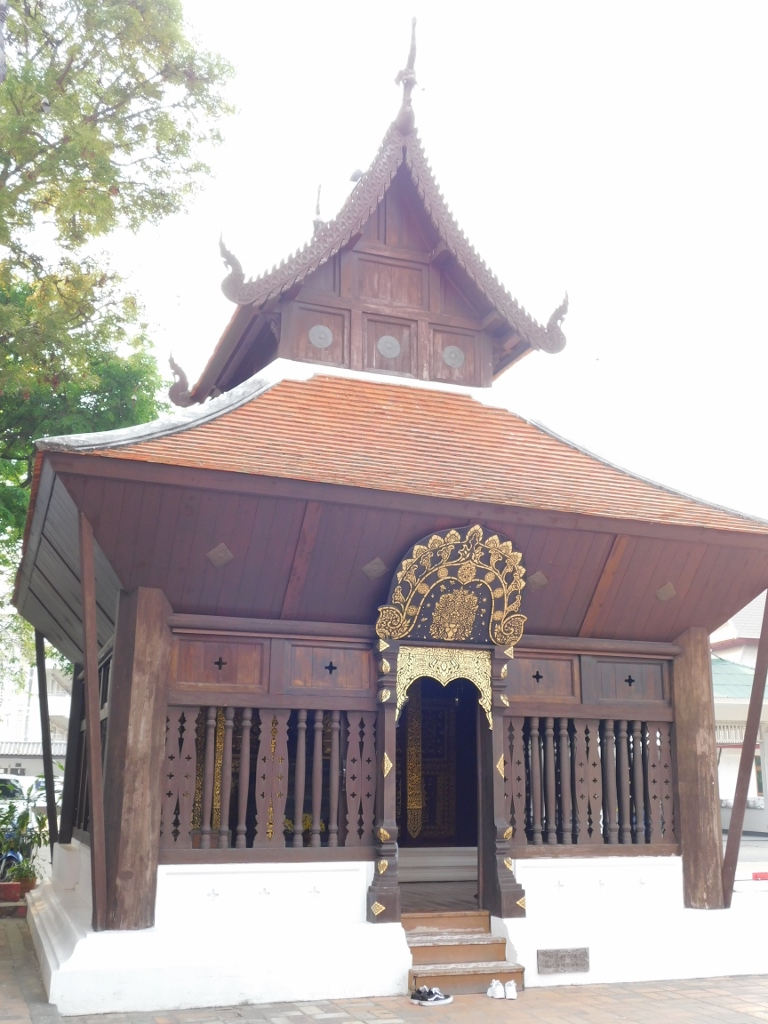 Wat Chedi Luang, a detail
Wat Chedi Luang, a detail
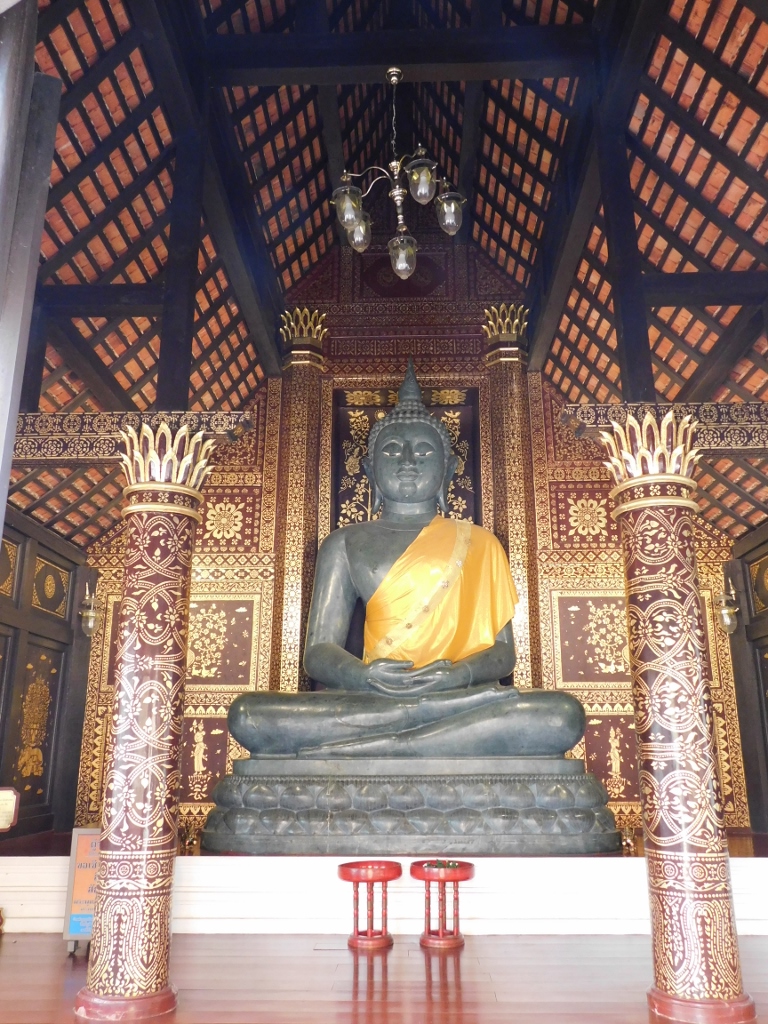 Wat Chedi Luang, a detail
Wat Chedi Luang, a detail
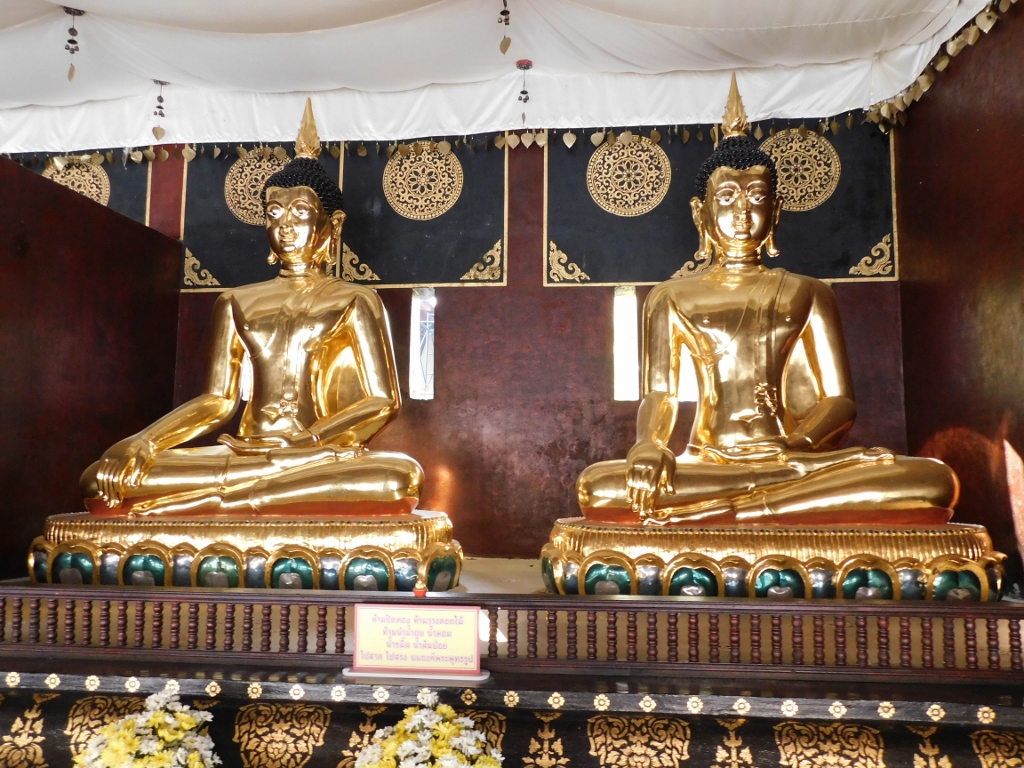 Wat Chedi Luang, a detail
Wat Chedi Luang, a detail
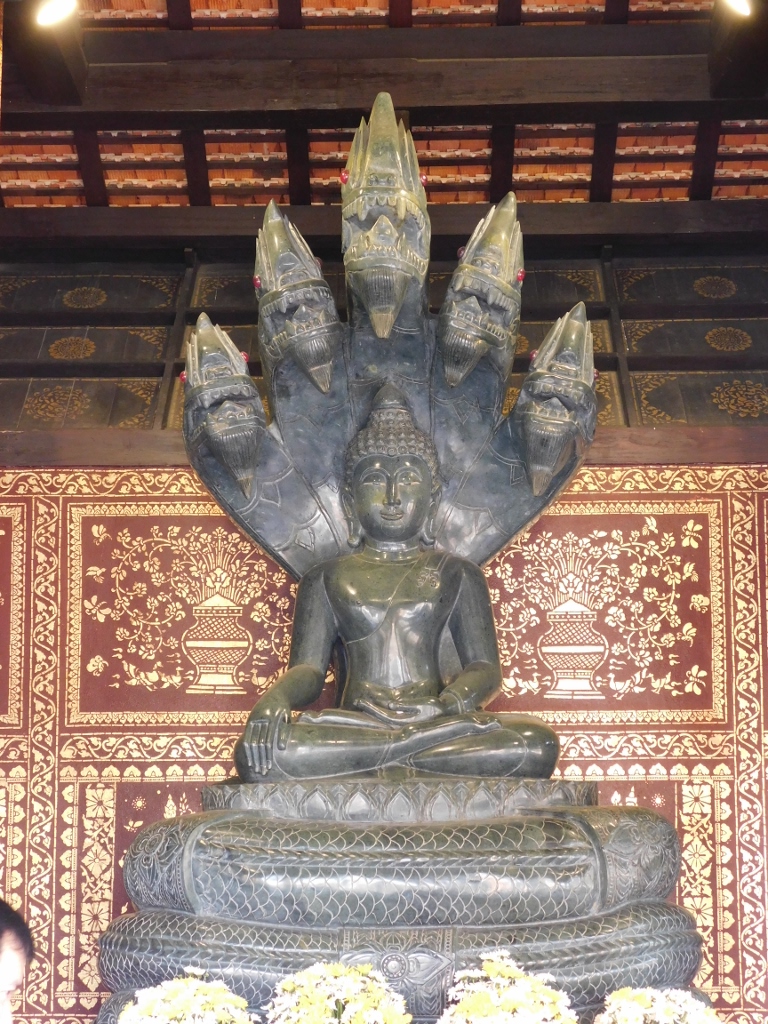 Wat Chedi Luang, a detail
Wat Chedi Luang, a detail
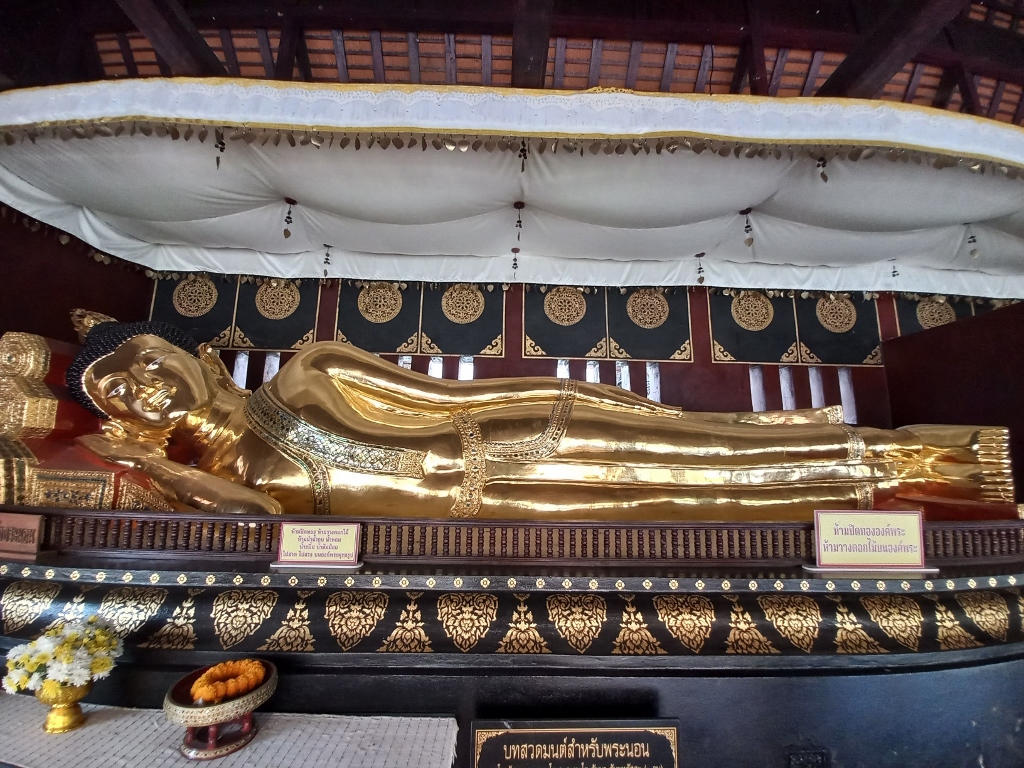 Wat Chedi Luang, a detail
Wat Chedi Luang, a detail
Here, I practically concluded the tour of Wat Chedi Luang and on my way to the exit, I passed by a beautiful structure housing the Buddhist Manuscript Library and Museum, which is a part of the temple complex.
 Wat Chedi Luang, Buddhist Manuscript Library and Museum
Wat Chedi Luang, Buddhist Manuscript Library and Museum
When I exited onto the street, I walked northwards because my hotel and a few other interesting places were in that direction. A few hundred metres further, I reached a spacious square, more like a plaza, and I first headed towards another significant temple. Along the way, I passed by an unnamed building, at least for me, but certainly very well-crafted.
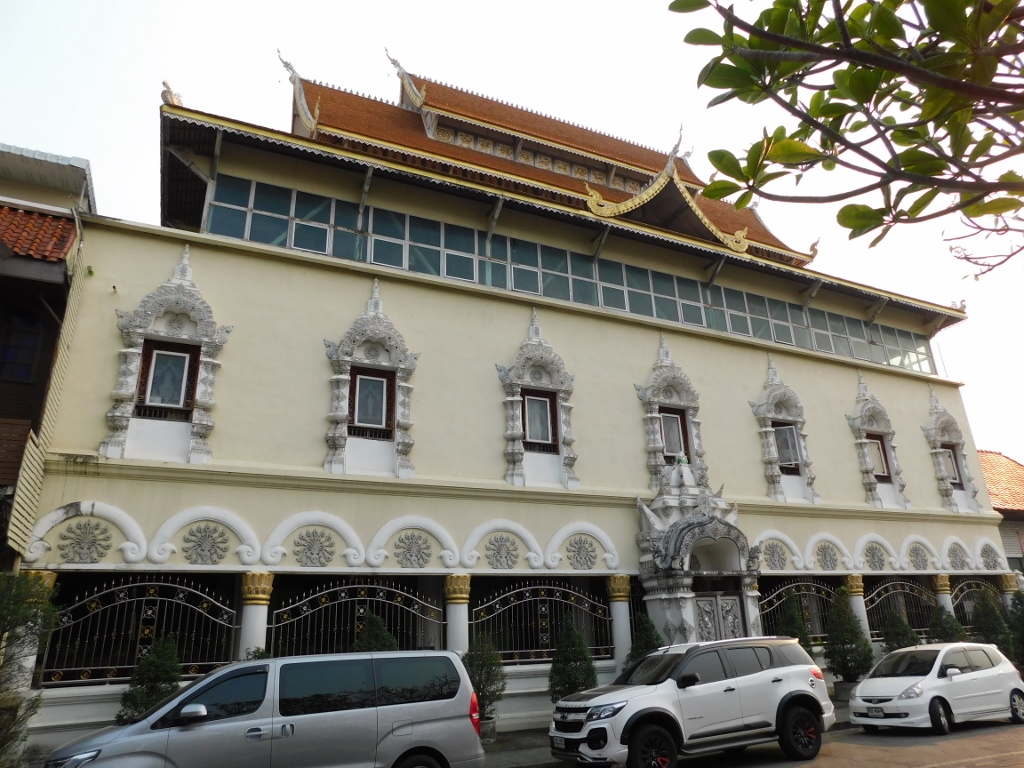 Chiang Mai, a detail
Chiang Mai, a detail
So, I have no idea what the purpose of this building is and when it was constructed, but, as a large structure in the heart of the city, it brought me back to the history of Chiang Mai and Thailand, although it might not be directly related to this story.
Namely, the British began to rule Burma in 1824, which is west of Thailand, while the French had their colonies to the east of Siam, encompassing territories that are a part of present-day Vietnam, Laos and Cambodia. And Thailand? Somehow, Thailand managed to avoid all of this and remained an independent country throughout the entire 19th century and the first half of the 20th century, when the colonies of the Western powers were already firmly established across South and East Asia. A more in-depth study of this history might reveal various strong influences from foreign powers, but the fact remains that Thailand was neither a colony of Great Britain nor France, nor any other European colonial power.
However, at one point, the British established their consulate in Chiang Mai and that was the first diplomat in the northern part of the country. This marked the beginning of the opening of this part of Siam to modern developments and influences from distant lands, bringing with it modern science, medicine, education and new architectural styles. That’s what triggered my association here, although it might not be directly connected.
In any case, in the immediate vicinity of this building there is a temple that I have previously mentioned as the place where the sacred City Pillar was originally kept from 1296 onwards. This temple is Wat Inthakhin.
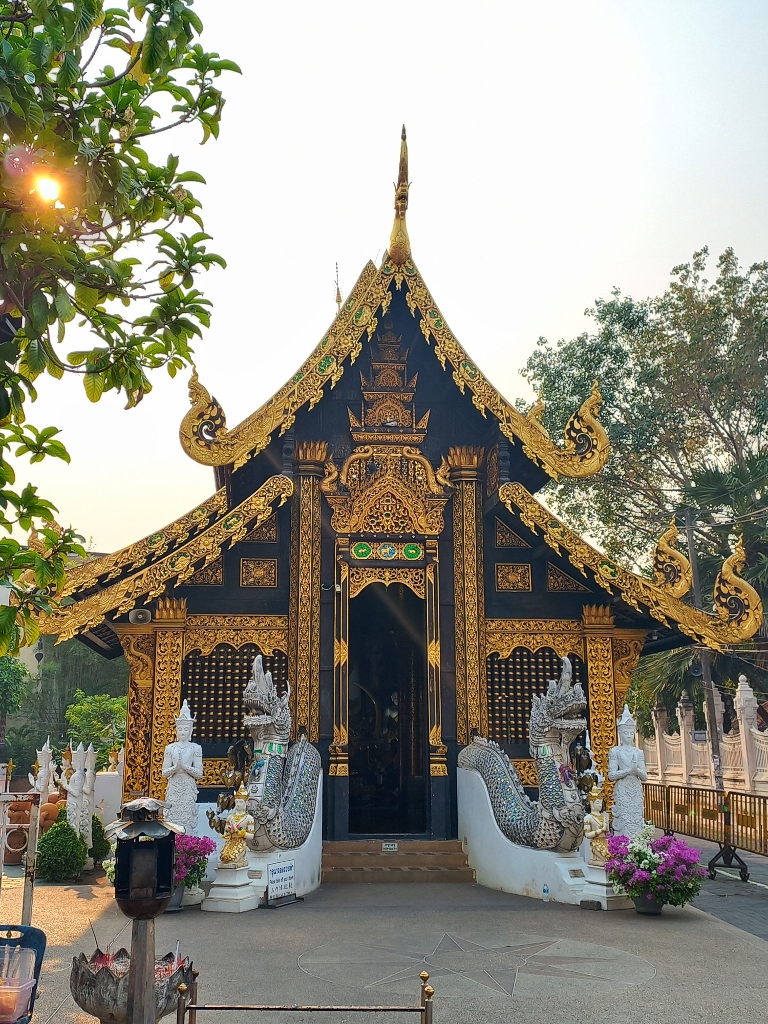 Wat Inthakhin
Wat Inthakhin
The exact founding date of this small temple is not known, but due to the fact that it housed the sacred pillar, this temple held great spiritual significance.
Although it was abandoned for a certain period of time in the past, today it is an active temple. The vihara seen here is of a more recent date and was built to house Buddha images, including the main Buddha figure that dates back to 1794.
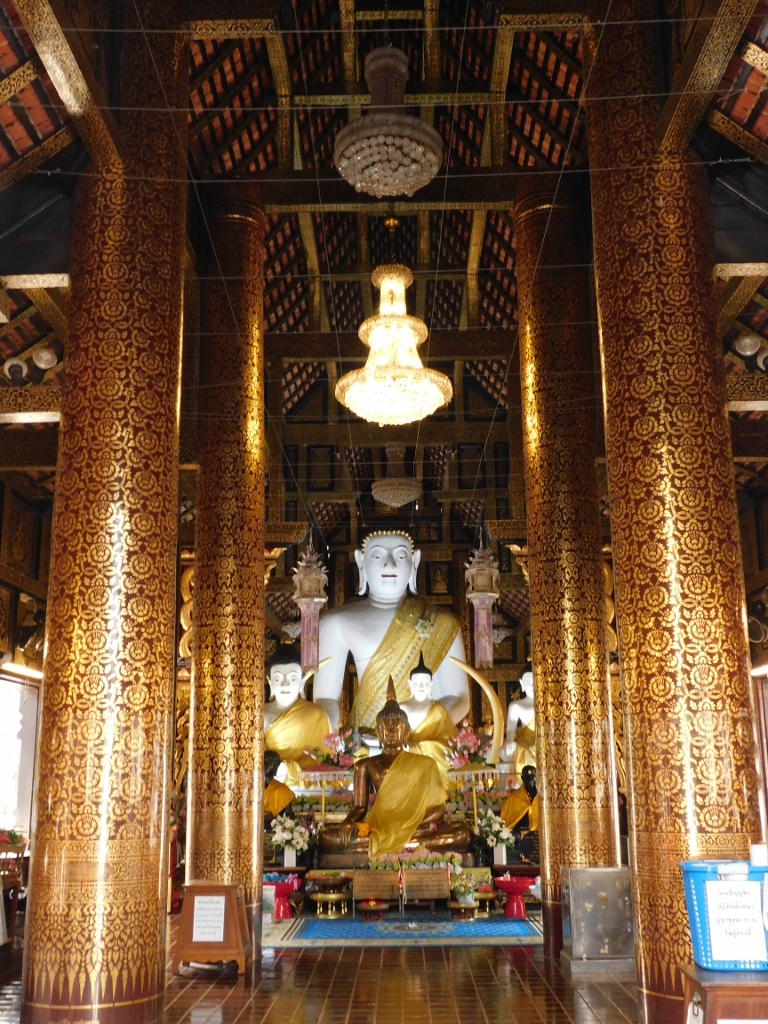 Wat Inthakhin, a detail
Wat Inthakhin, a detail
Within this temple, there are two chedis, with one being more prominent. The round chedi seen on the left dates back to the 15th century, while the vihara is on the right-hand side. As mentioned before, this is a very small temple, as illustrated in the following picture.
 Wat Inthakhin
Wat Inthakhin
Here, I lingered for just a moment to capture a detail that adorns the lateral parts of the vihara – charming chubby children figures.
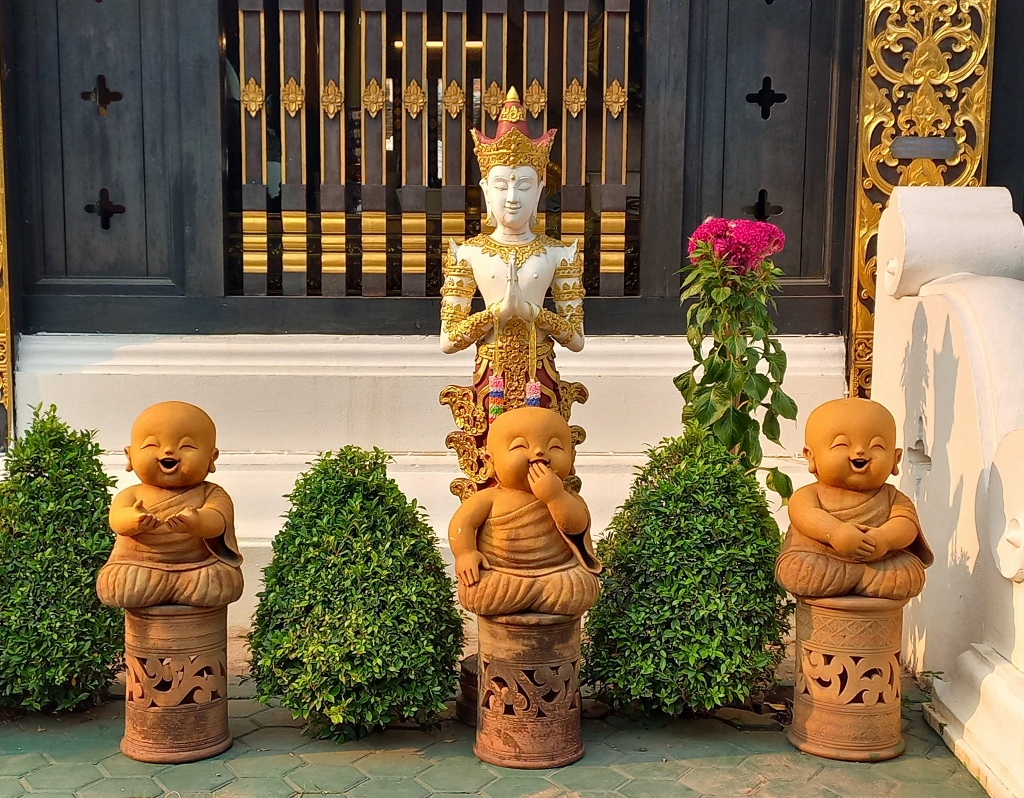 Wat Inthakhin, a detail
Wat Inthakhin, a detail
So, right on the other side of the street, there is the square I have mentioned, whose peripheral parts look more like a park. The only unusual thing was the fact that the trees were “dressed up.”
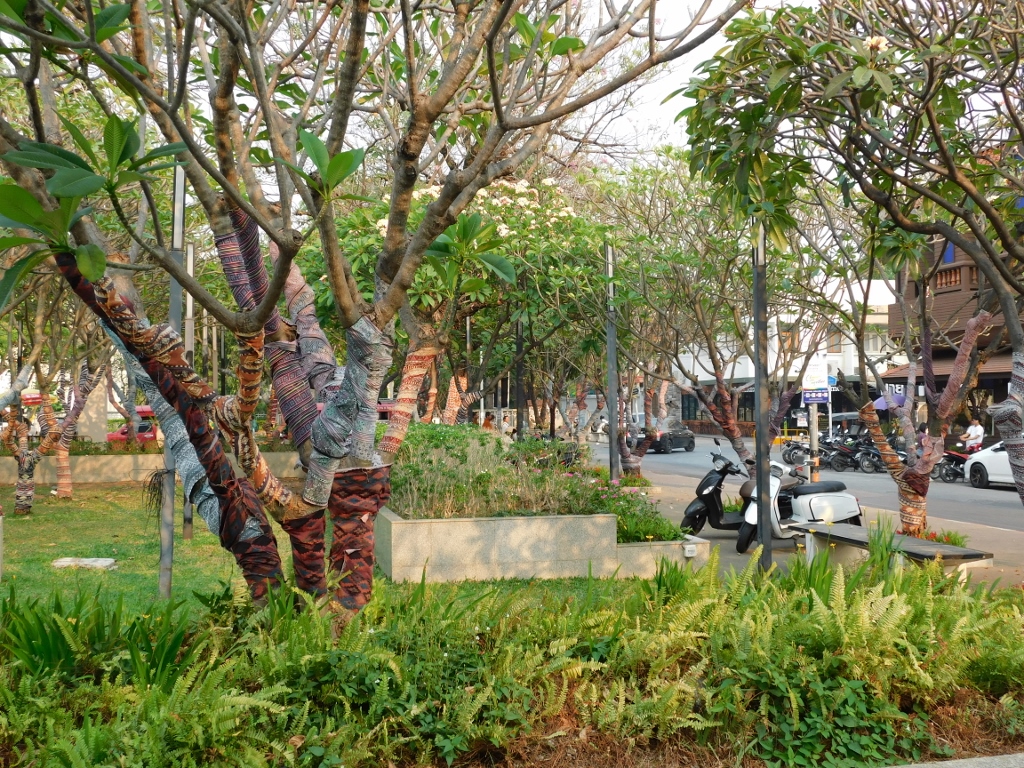 Chiang Mai, a detail
Chiang Mai, a detail
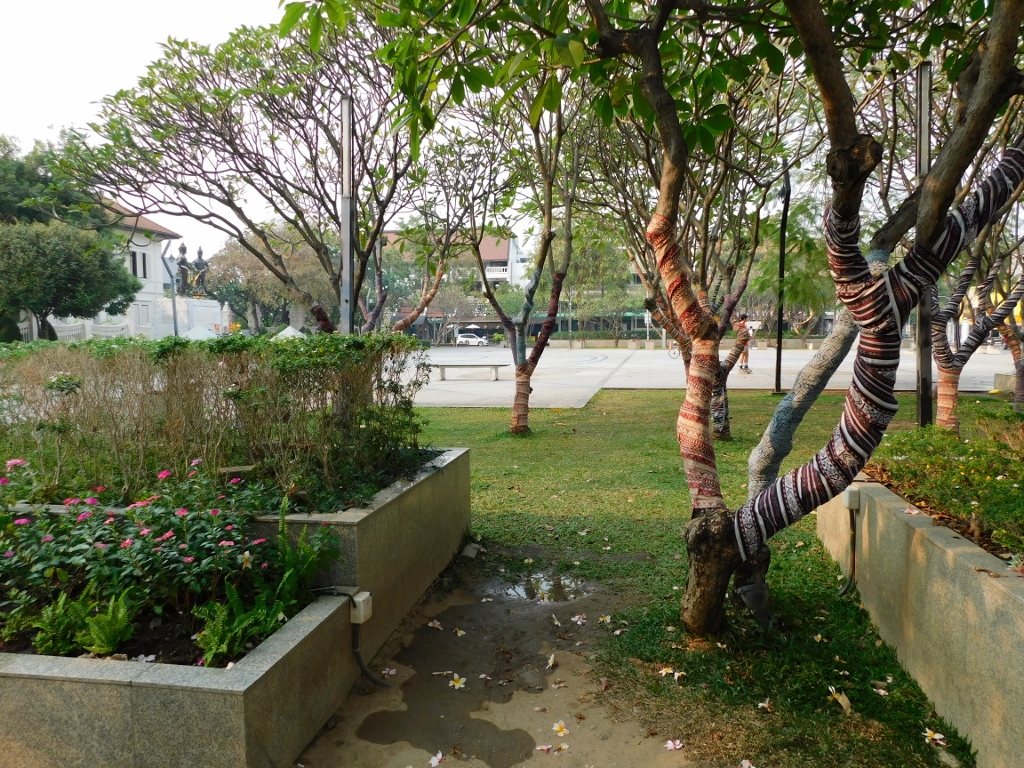 Chiang Mai, a detail
Chiang Mai, a detail
If you look more closely at the previous photo, a bit further and to the left, you can see some sculptures. This is the Three Kings Monument.
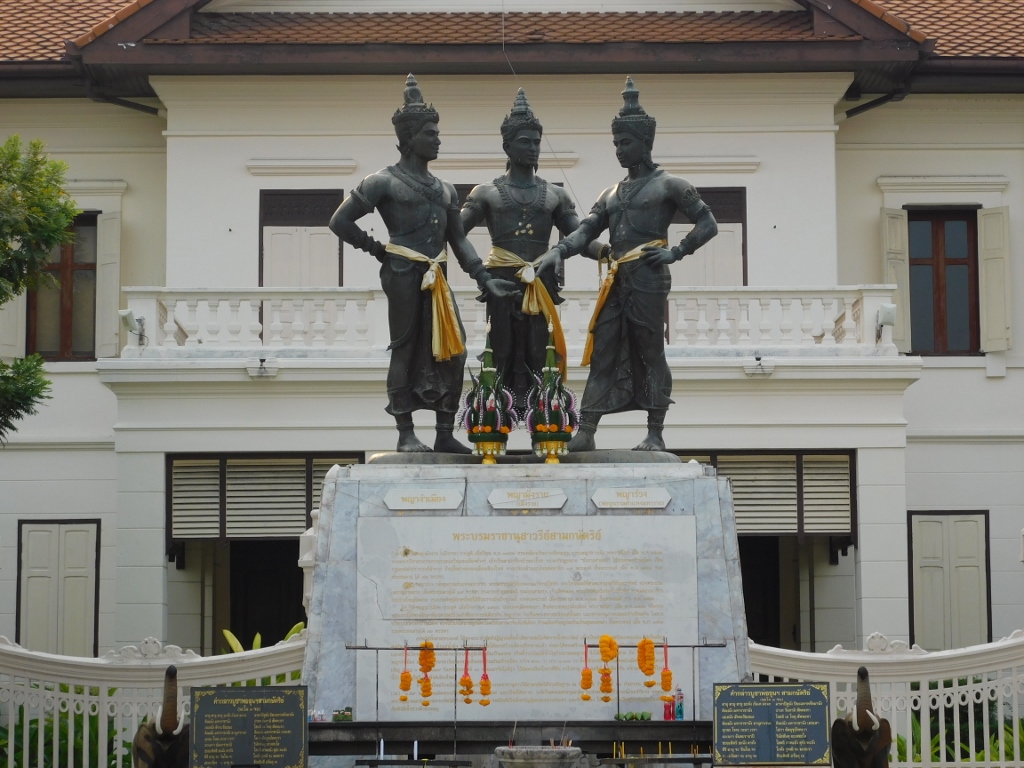 Three Kings Monument
Three Kings Monument
Namely, at the time when King Mangrai was contemplating whether to establish his new capital at the location of present-day Chiang Mai, he first consulted his noblemen and astrologers, and then he also sought advice from his two sworn brothers – the rulers of the Phayao and Sukhothai kingdoms. Since 1287, he had formed a pact with them for a strategic alliance against foreign enemies, a rather unique and significant arrangement for the region. In any case, today, in the centre of Chiang Mai, you can see this monument to the three kings.
Directly across from this monument is the Lanna Folklife Museum, essentially an ethnographic museum housed in the former Provincial Court building from 1935.
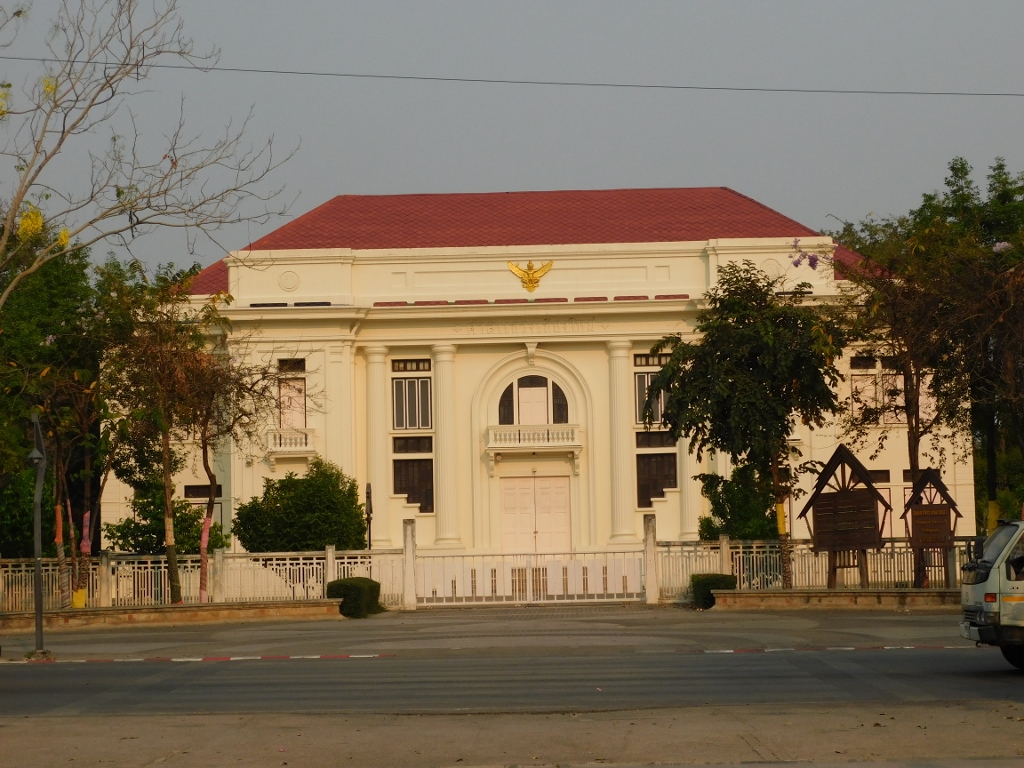 Lanna Folklife Museum
Lanna Folklife Museum
I had read very positive reviews about this museum and a few others, but unfortunately, I didn’t have the time for such activities.
On this occasion, I just took some photos of the beautiful flowers of the plumeria or frangipani plant (Plumeria Alba) that grow around the square and then I simply continued walking to the north part of the ancient city.
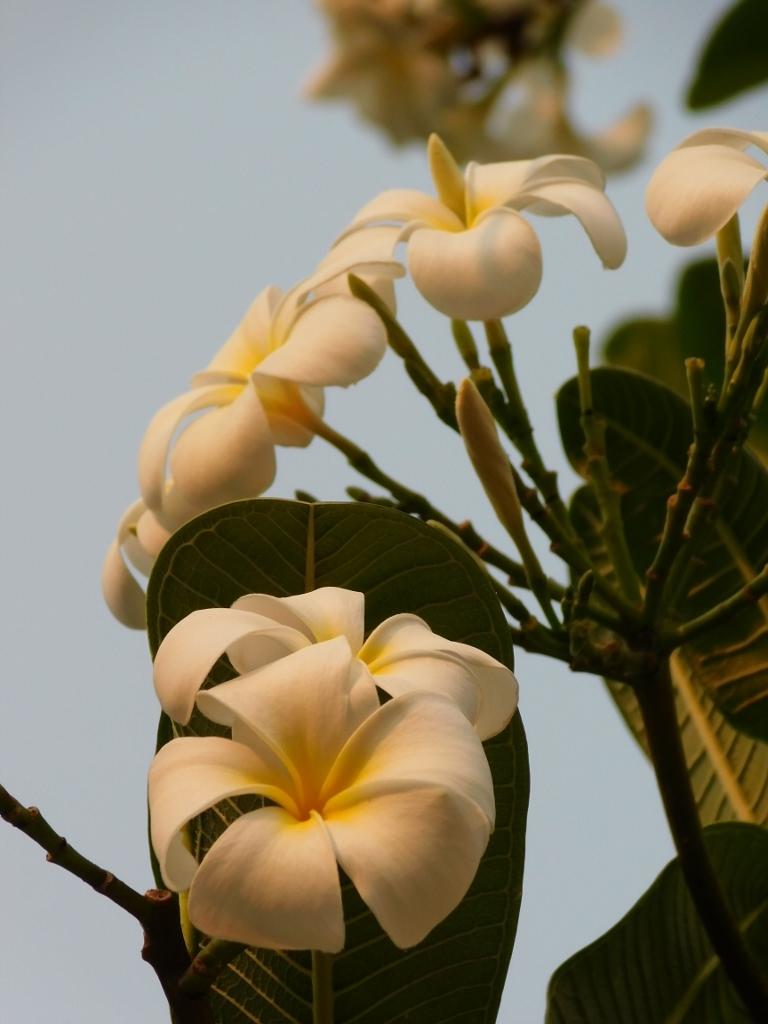 Plumeria or frangipani flowers
Plumeria or frangipani flowers